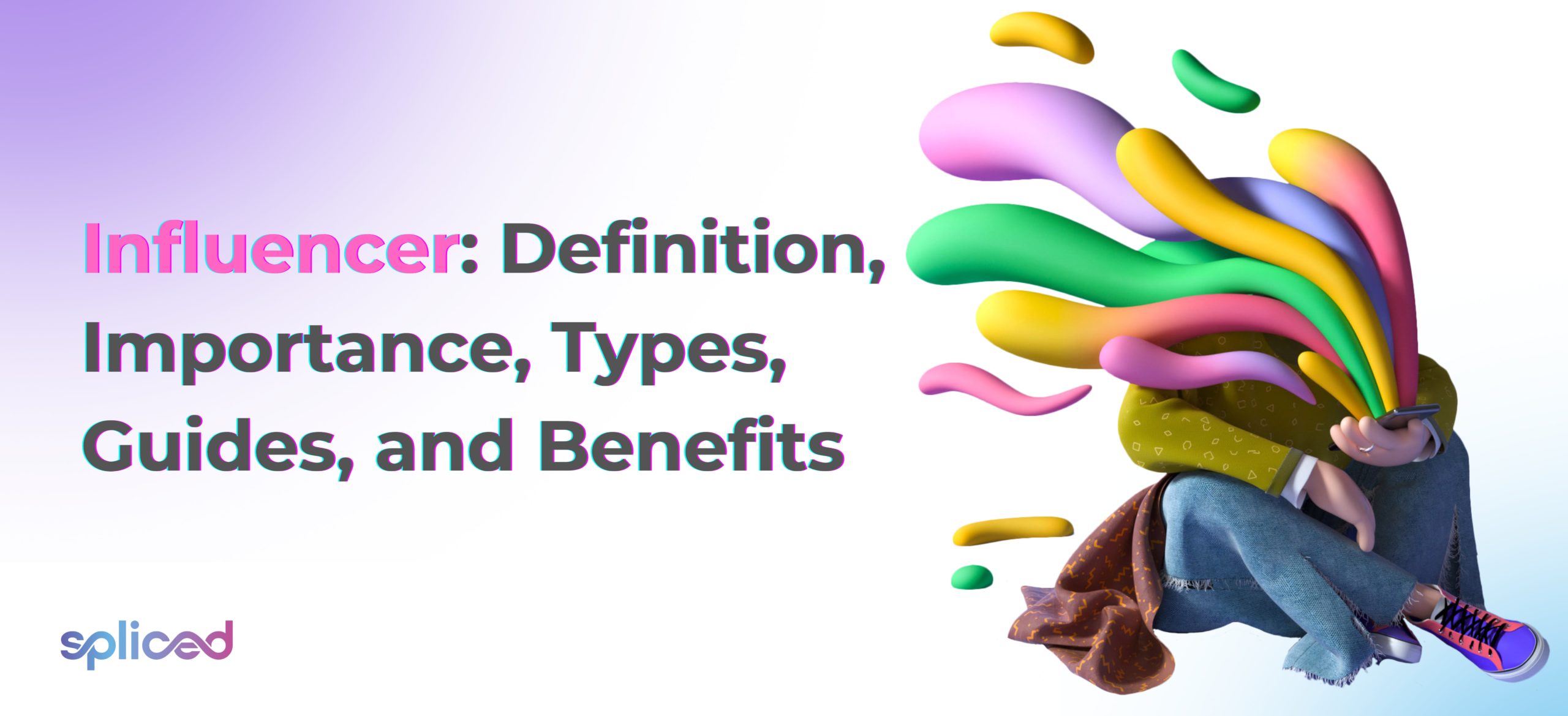A social media “influencer” is someone who has established a sizable online following by being an authoritative voice in their field or by constantly producing relevant material. Influencers sway their followers ‘ judgments, purchases, and actions because of the respect and trust they have earned in their communities. Influencers are useful allies for brands and enterprises because of the material they create, the items they advocate, and the trends they set. They are pivotal in driving consumer behavior, industry trends, and brand perceptions in the ever-changing digital media landscape. Influencers sway the judgment of their devoted fan base by virtue of their extensive internet following and knowledge in a particular field.
Find and collaborate with influencers strategically to advocate a business through their reach and authenticity. Start by finding influencers with brand values and target demographic audiences. Find influencers via social media, influencer marketing tools, and agency collaborations. Understand the influencer’s content, engagement rates, and preferences to communicate and create partnerships. Consider remuneration, content, and campaign goals when negotiating collaboration conditions. Create a collaborative environment that gives influencers creative flexibility and brand alignment. Analyze campaign performance and improve strategies. Businesses locate and work with influencers to boost brand visibility and reputation by adhering to these steps.
Each level of influencer, from the tiniest nano-influencers to the largest mega-influencers, has its own set of pros and downsides. Influencers wield significant benefits for brands and businesses, acting as authentic voices that resonate with niche audiences, driving engagement, and fostering trust. They provide a platform for authentic storytelling and product promotion, reaching a diverse and often highly engaged demographic.
Influencers swiftly amplify brand visibility, enhance credibility, and facilitate access to new markets. However, navigating the influencer landscape comes with its limitations. Authenticity is compromised, and partnerships need to have the desired impact carefully chosen. Influencer marketing requires careful management to ensure compliance with ethical standards, and the rapidly evolving nature of social media platforms poses challenges in maintaining sustained relevance. Striking a balance between the benefits and limitations is vital for businesses seeking to leverage influencers’ power effectively.
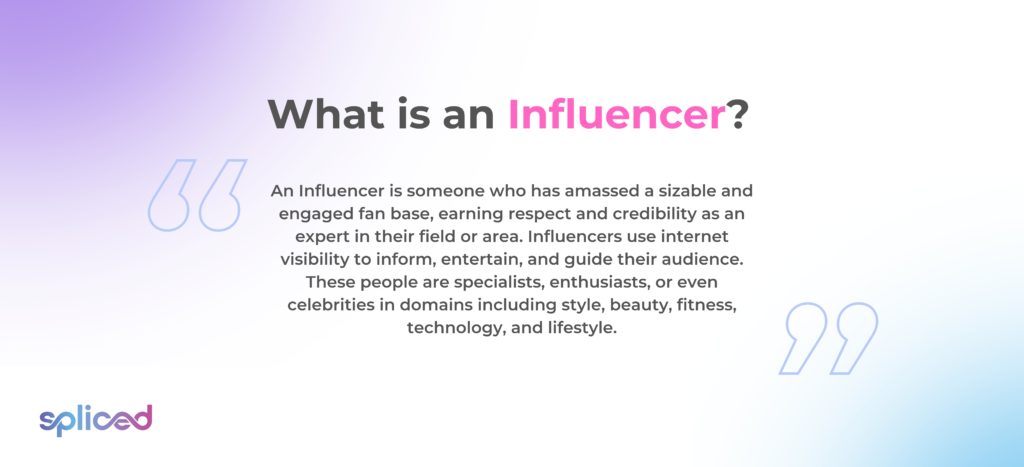
What is an Influencer?
An Influencer has amassed a sizable and engaged fan base, earning respect and credibility as an expert in their field or area. Influencers use internet visibility to inform, entertain, and guide their audience. These people are specialists, enthusiasts, or even celebrities in style, beauty, fitness, technology, and lifestyle.
Influencers sway consumer choices, cultural movements, and public judgment due to their sway over their audience. “What is an influencer?” is a common question individuals ask unfamiliar with social media marketing and digital advertising. Brands frequently work with influencers for promotional purposes, hoping to piggyback on the latter’s popularity and fan base to boost awareness of the brand’s wares. Authenticity is the cornerstone of any influencer’s connection with their audience, and the most productive influencers are those who foster authentic relationships with their fans and regularly release engaging content.
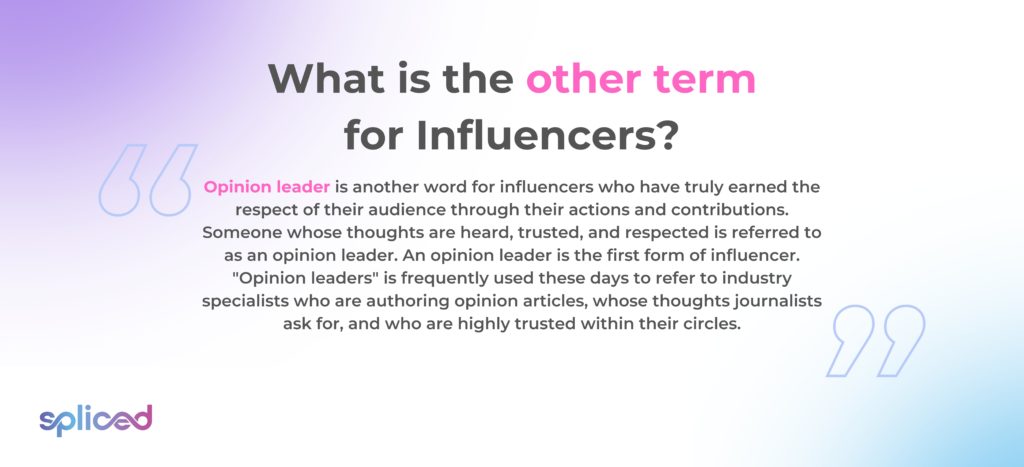
What is the other term for Influencers?
Opinion leader is another word for influencers who have truly earned the respect of their audience through their actions and contributions. Someone whose thoughts are heard, trusted, and respected is referred to as an opinion leader. An opinion leader is the first form of influencer. “Opinion leaders” is frequently used to refer to industry specialists who are authoring opinion articles, whose thoughts journalists ask for, and who are highly trusted within their circles. Influencers with a long-term exclusive association with a certain brand are referred to as brand ambassadors by that particular brand. The term “influencer” is used interchangeably with terms such as “leader,” “bellwether,” “motivator,” “inspirer,” “trendsetter,” “fashionista,” and “celebrity.”
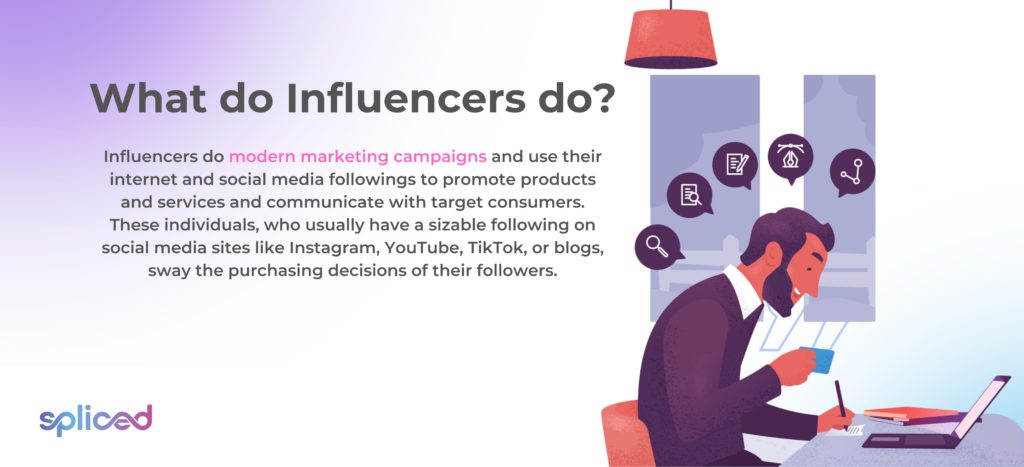
What do Influencers do?
Influencers do modern marketing campaigns and use their internet and social media followings to promote products and services and communicate with target consumers. These individuals, who usually have a sizable following on social media sites like Instagram, YouTube, TikTok, or blogs, sway the purchasing decisions of their followers.”Influencers” together with marketers develop a loyal following by sharing original, engaging content in popular sub-genres including fashion, health, travel, and lifestyle. They effortlessly blend promotional material with their distinct style in content like sponsored articles, product reviews, tutorials, and lifestyle vlogs.
A large part of an influencer’s attraction comes from the fact that they establish a genuine rapport with their followers. Companies see influencers as a valuable resource for spreading the word about their wares among a specific audience. Influencer marketing has emerged as a powerful and adaptable strategy for organizations trying to connect with consumers in today’s digital and social media-driven world. Influencers and businesses benefit from increased exposure to their carefully selected and highly engaged audience as a result of their mutually beneficial partnership. The influence of influencers on consumer behavior and the marketing environment is anticipated to remain significant as the role of influencers expands and changes.
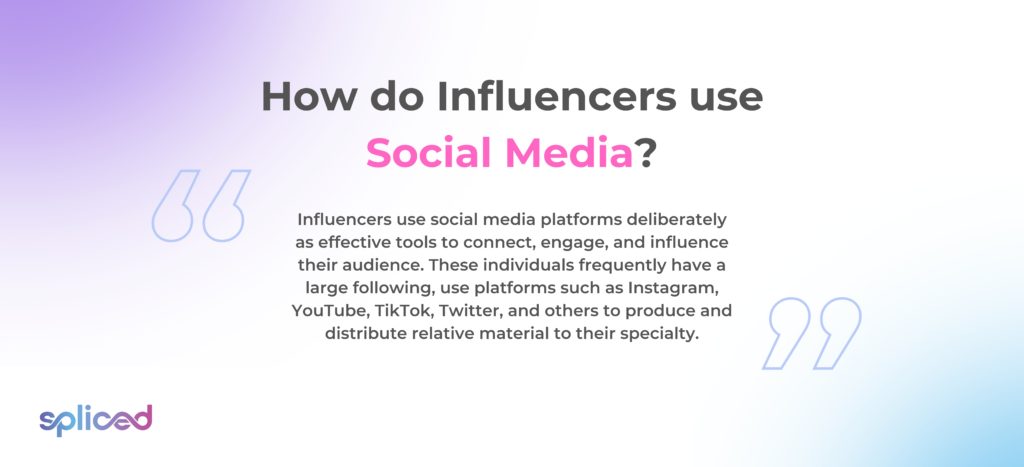
How do Influencers use Social Media?
Influencers use social media platforms deliberately as effective tools to connect, engage, and influence their audience. These individuals frequently have a large following, use platforms such as Instagram, YouTube, TikTok, Twitter, and others to produce and distribute relative material to their specialty.
Instagram is a popular tool for influencers because it enables them to publish aesthetically appealing content, such as images and short videos, frequently accompanied by commentary and hashtags. Longer-form content, such as vlogs, tutorials, and in-depth reviews, is popular on YouTube.
TikTok has become a medium for short-form, engaging videos, particularly among younger people. Twitter is used to deliver real-time updates, ideas, and conversations. Influencers adjust their material to the user preferences of each platform. Their audience is engaged through comments, direct messaging, polls, and interactive features. Hashtags are carefully utilized to boost exposure and reach.
Influencers share their everyday lives, ideas, and skills with their followers, generating a sense of connection and relatability because of the nature of social media. Influencers and brands work together to reach such an engaged audience, frequently through sponsored posts, product placements, or brand collaborations. Influencers’ symbiotic relationship with social media has revolutionized how products are sold, with influencers serving as genuine middlemen between firms and customers.
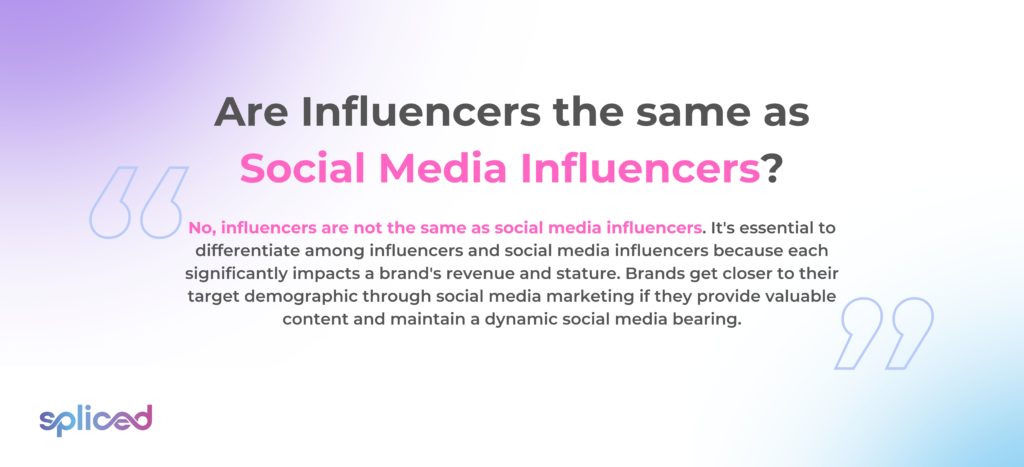
Are Influencers the same as Social Media Influencers?
No, influencers are not the same as social media influencers. It’s essential to differentiate among influencers and social media influencers because each significantly impacts a brand’s revenue and stature. Brands get closer to their target demographic through social media marketing if they provide valuable content and maintain a dynamic social media bearing. Influencer marketing, on the other hand, capitalizes on the fame and respect their target viewers already have for well-known figures in the industry.
The line between these two categories is blurry because of the pervasiveness of social media as the primary means by which influencers communicate with and sway their respective audiences. The phrase “Social Media Influencers” highlights that these individuals have the most impression on social media sites like Instagram, YouTube, TikTok, and Twitter, while influencers technically work anywhere. All influencers, in general, are social media influencers, but not all are influencers.
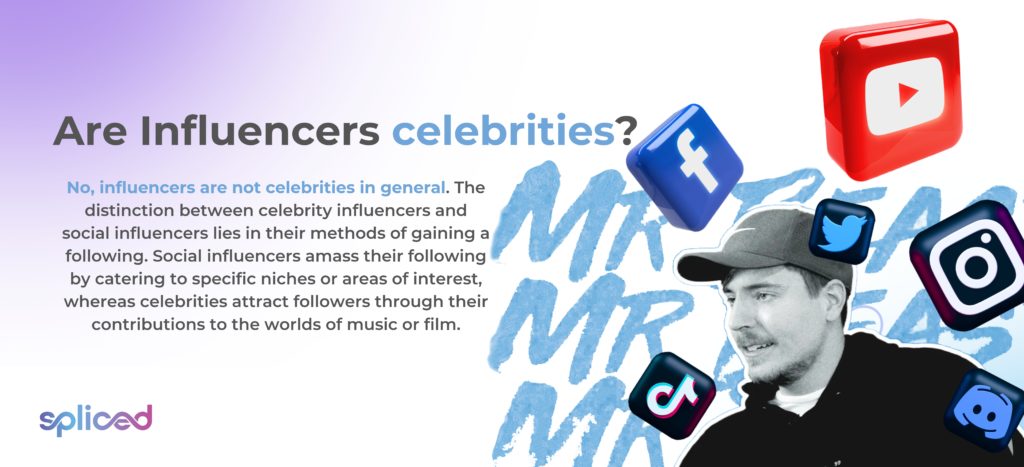
Are Influencers celebrities?
No, influencers are not celebrities in general. The distinction between celebrity influencers and social influencers lies in their methods of gaining a following. Social influencers amass their following by catering to specific niches or areas of interest, whereas celebrities attract followers through their contributions to the worlds of music or film. The majority of bloggers and influencers carve out a unique niche for themselves, marked by their distinct personal style, culinary expertise, or fitness regimens.
They acquire followers who impart their interest and intent to learn more about the topic. Consequently, when they market a product that aligns with their interests, it is more likely to resonate with their audience and increase their return on investment. Social influencers are more likely to have a relationship with the product and a cause to advertise it, as opposed to celebrities who merely associate their name with a brand to grow recognition.
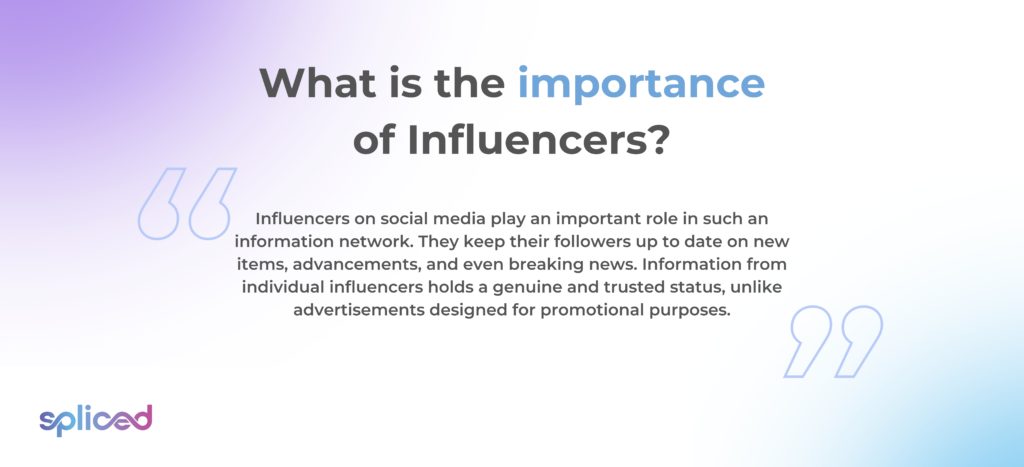
What is the importance of Influencers?
Influencers on social media play an important role in such an information network. They keep their followers up to date on new items, advancements, and even breaking news. Information from individual influencers holds a genuine and trusted status, unlike advertisements designed for promotional purposes. Surveys reveal that bloggers are the most trusted and influential information sources for B2B decision-makers, surpassing the impact of trade exhibitions and word-of-mouth recommendations. Recognizing the pivotal role these influencers must play in disseminating our messages is imperative.
It is vital to consider how influencers curate information. Many influencers have created a name for themselves just by posting and sharing data from other sources in a relevant and interesting manner. Individuals must comprehend both sides of the coin it is amazing to have these “citizen journalists” distributing information and news in an accurate and timely manner that is sometimes not achievable with regular media outlets.
News and information propagate rapidly and endure when a social media influencer introduces a story on social media. Bloggers operate within a framework that affords them greater latitude, unlike professional journalists who adhere to rigorous ethical standards. The swiftness with which misinformation circulates remains a pertinent concern, while the overwhelming majority of bloggers aspire to maintain integrity. Nurturing strong relationships with such influencers becomes a paramount priority, positioning an individual or entity as a primary bulwark and an indispensable information source before any corporate data sees the light of day.
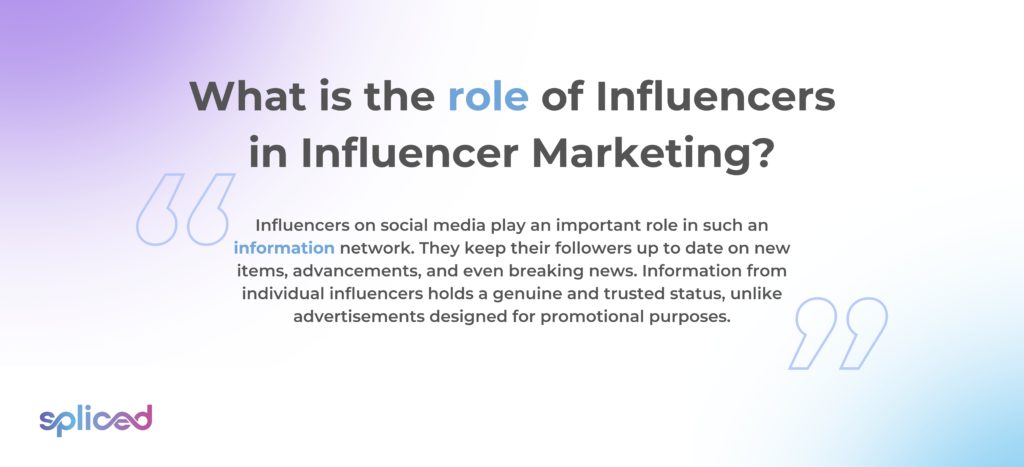
What is the role of Influencers in Influencer Marketing?
The role of influencers in Influencer Marketing is to act as authentic and relatable bridges between brands and their target audiences. Using popular people to spread the word about your brand on social media is called “influencer marketing.” These influencers are personalities who have a sizable online following and are often regarded as authorities in their profession. Many companies now work with well-known online opinion leaders to spread the word about their wares.
The concept of “influencer marketing” is straightforward. Companies look for “influencers” who appeal to their desired demographic. The next step is for them to approach these influencers with a campaign collaboration proposal. The influencer then publishes and distributes the content, which serves to promote the brand’s offering. Sponsored Instagram posts and video reviews of products on YouTube are only two examples of influencer marketing strategies. The key to effective influencer marketing is making genuine and exciting material for the influencer’s target demographic. Extensive planning and communication between the company and the influencer is required to ensure the material is consistent with the brand and conveys the intended message.
There are a lot of upsides to using influencer marketing. Brands reach a sizable, interested audience and, in the process, gain reputation and trust among buyers. A consumer’s trust in a suggestion from an influencer is much higher than their trust in a regular advertisement. It has the potential to boost sales, brand recognition, and consumer participation. Influencer marketing has shown to be an efficient and successful strategy for many brands. Brands propel their businesses forward with the support of social media influencers by collaborating with them to come up with engaging content.
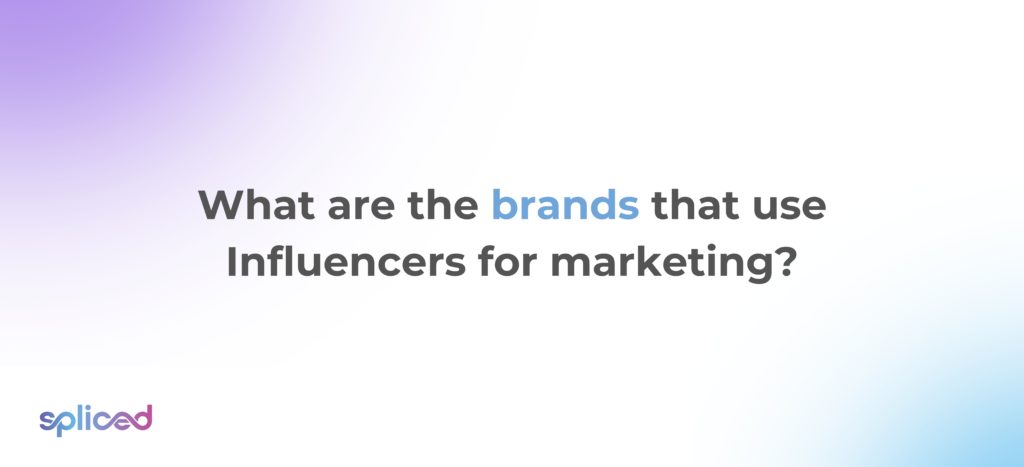
What are the brands that use Influencers for marketing?
The brands that use Influencers for marketing are listed below.
- Playstation: PlayStation teamed with five gaming influencers to boost its new virtual reality headsets, focused on Instagram and YouTube in Canada. The strategy targeted macro, micro, and nano-influencers in order to increase interaction and bridge the gap between tech-savvy and players. The influencers, who have Instagram followings ranging from almost 10,000 to 72,000, shared posts using the hashtags #PlayStationVR, #ITriedPSVR, and #PSVR and tagged @PlayStationCA. PlayStation promoted the brand and the PlayStation VR to millions of prospective buyers via cross-channel hype on Instagram and YouTube.
- Dunkin’ Donuts: Strategic influencer marketing is a big reason why Dunkin’ Donuts has amassed 3 million followers and 21.3 million likes on TikTok. They reached a multi-year sponsorship deal with Charli D’Amelio, the account with the most followers on TikTok, and made it official that Charli is going to be promoting Dunkin’ using TikTok content showing her actually placing an order for the beverage. Dunkin’ Donuts launched a viral promotion dubbed #CharliXDunkinContest and two beverages named after Charli, the first of which was “The Charli.” Launch day app downloads for “The Charli” increased by 57%, while the following day cold brew sales increased by 45%.
- Levi’s: Levi’s “Buy Better, Wear Longer” campaign features a collaboration with singer/actor Jaden Smith and influencer Emma Chamberlain to bring attention to Levi’s environmental initiatives and the overconsumption in the fashion industry. Smith and Chamberlain discuss their own conscious consumption for the world and wearing Levi’s in the campaign video, reiterating the initiative’s call for consumers to purchase secondhand and commit to quality sustainably sourced fabrics. Chamberlain and Smith are genuine advocates for their respective causes, and their massive social media followings are just the tip of the iceberg. Chamberlain has 11 million YouTube subscribers and 14.4 million Instagram followers, while Smith has 8 million Twitter followers.
- Häagen-Dazs: The marketing firm TAKUMI spearheaded a #HaagIndoors campaign across many social media platforms to promote the new Secret Sofa project, increase brand favorability, and boost Häagen-Dazs sales on Amazon Prime Now. TAKUMI collaborated with twenty-four nano and micro-influencers for the campaign, each of whom contributed creator-led material once a week. Influencer marketing led to a near twofold rise in weekly sales of Häagen-Dazs on Amazon as word of mouth and user-generated content spread on social media sites like Instagram, Facebook, and TikTok. 450+ influencers produced content that was viewed nearly 3 million times ove the course of the 8 weeks, with engagement rates of 18.9% for TikTok and 4.15% for Instagram.
- Magnum: Magnum has teamed up with Digital Voices to promote their new “True To Pleasure” campaign, which features a song written and performed by multi-platinum artist and campaigner Halsey. The ad has a video, a Magnum lens for Snapchat effects, and the participation of a global ensemble, including Halsey, who each share their own truths to pleasure. The campaign introduced the Magnum Ruby ice cream flavor and promoted the brand’s True To Pleasure philosophy through the social media platforms Instagram and TikTok. Magnum’s history is steeped in collaborations with artists of all stripes, both renowned and up-and-coming, as well as cultural heavyweights. The campaign’s success is attributed to the fact that Halsey exemplifies the campaign’s core ideals, which include creativity, overcoming obstacles, expressing oneself freely, and being “True To Pleasure.”
- Gymshark: Gymshark has used influencer marketing extensively over the past few years, but its 66-day “Change Your Life” challenge was especially fruitful. Gymshark turns Gymshark 66 into a 66-day event and competition in which users challenge themselves to adopt more positive behaviors in exchange for points and rewards at the end of the challenge. Gymshark embraced video content by teaming up with influencers who have a larger following on TikTok; as a result, the hashtag #gymshark66 received 241.3 million views on TikTok and approximately 750,000 shares on Instagram. Gymshark used Instagram’s IGTV for a “Stories of the 66” video series in which people talked about their experiences switching to healthy habits in 66 days, while influencers used TikTok to share the #gymshark66 campaign.
- Moncler: Moncler’s #MonclerBubbleUp campaign became popular on TikTok with the help of big names in the fashion world like Bella Poarch and Charli D’Amelio. The challenge films featured Moncler’s iconic bubble coat design and urged viewers to reproduce the look with materials found around the home. The videos were matched to a tune that was a popular sound on TikTok at the time. The challenge had 7.6 billion views and was successful in raising awareness and participation among Generation Z, starting with a relatively unknown Italian high fashion brand.
- Benefit Cosmetics: Influencer Manny MUA spearheaded the #benefitofcrocschallenge, which was a huge success for Benefit Cosmetics and Crocs. Participants in the cosmetics challenge wore Crocs on their hands while they went through their usual beauty rituals, which they posted to TikTok and Instagram Reels. Strategic thinking went into selecting Manny as the influencer to collaborate with because the personality is not just a prominent beauty influencer with brand affinity for Benefit and Crocs but has 4 million followers. The limited edition Crocs line sold out in record time with the help of the challenge.
- Tinder: Over half of Tinder’s user base is under the age of 25, so the company sought out Gen-Z celebrities to spread the word. Tinder targeted mega-influencers and TikTok content makers with great organic engagement from their followers and a history of successfully integrating paid posts into lifestyle content for its 2021 influencer campaign.
- Chipotle: Chipotle is another example of a food company that has used influencer marketing extensively. They created a Chipotle Creator Class of 15 influencers recently, including viral TikTok creators, to work with and promote Chipotle. Previous partners include David Dobrik and Shawn Mendes. Working with drag queens to promote products and services during Pride Month in the summer of 2021 proved to be a fruitful influencer marketing strategy. Each of the three drag queens’ favorite Chipotle meals was highlighted on the Chipotle app and website, and $1 from the sale of each meal was contributed to an LGBTQ+ charity as part of the campaign. Chipotle frequently forms partnerships with influential people; one such partnership was with TikTok star Christina “Tinx” Najjar, who has 1.4 million followers. Chipotle reached more people thanks to Tinx’s devoted fan base, who watched the influencer’s suggestions, content, and vlogs and even bought the bespoke bowl, the Tinx Bowl.
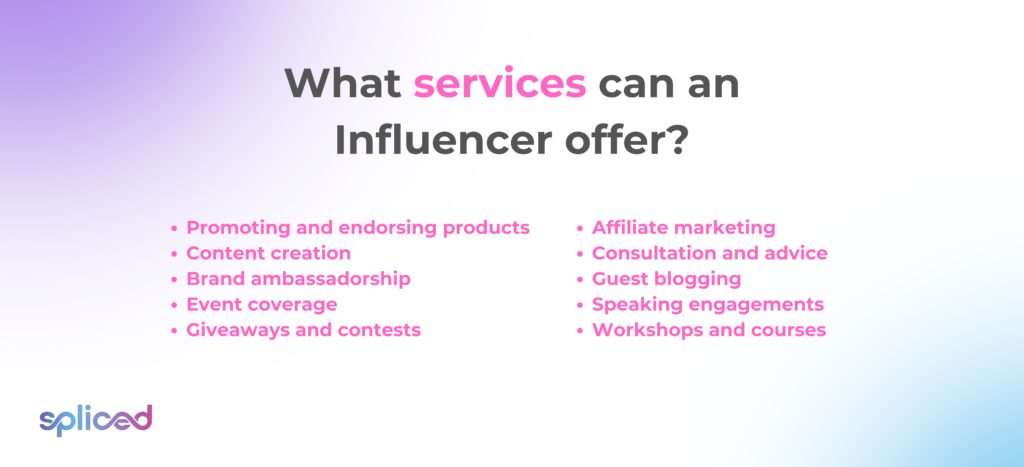
What services can an Influencer offer?
The services an Influencer can offer are listed below.
- Product Endorsements: Influencers assist firms to reach a wider audience by promoting and endorsing products through sponsored posts, reviews, or unboxing videos.
- Content Creation: Influencers are knowledgeable content makers. They create compelling photographs, films, or textual content consistent with a brand’s message and appeals to their target audience.
- Brand Ambassadorship: Influencers have the ability to develop long-term relationships with brands, becoming ambassadors who continuously promote and represent the brand over time.
- Event Coverage: Having influencers present at events allows for real-time updates and creating content that highlights the event or product launch.
- Giveaways and Contests: Promotional gifts and contests by influencers engage audiences and promote businesses in a fun way.
- Affiliate Marketing: Affiliate connections allow influencers to earn commissions on sales through their unique links, making the partnership performance-based.
- Consultation and Advice: Some influencers provide consulting services, offering their knowledge of content development, social media strategy, or niches.
- Guest Blogging: Influencers are capable of writing guest pieces for blogs or websites, giving their ideas, experiences, and knowledge in their industry.
- Speaking Engagements: Conferences, webinars, and events typically include influential people with a large following and experience.
- Workshops and Courses: It is possible for influencers to teach their audience new skills and information through the creation and sale of online courses or in-person workshops.
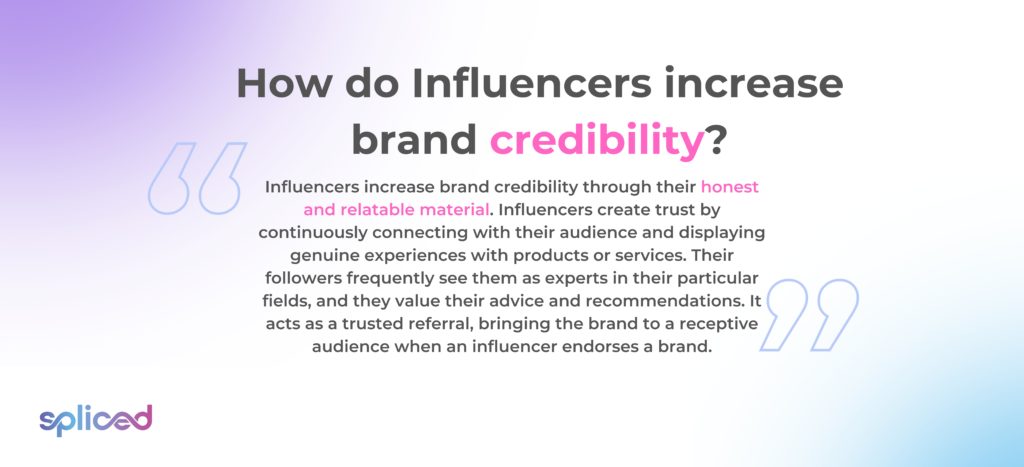
How do Influencers increase brand credibility?
Influencers increase brand credibility through their honest and relatable material. Influencers create trust by continuously connecting with their audience and displaying genuine experiences with products or services. Their followers frequently see them as experts in their particular fields, and they value their advice and recommendations. It acts as a trusted referral, bringing the brand to a receptive audience when an influencer endorses a brand.
The transparency and authenticity of influencer marketing lead to increased reputation because followers value honest opinions and genuine experiences. Influencers are skilled at storytelling, constructing narratives around businesses that appeal to their audience, generating a sense of authenticity that traditional advertising frequently lacks. Influencers’ direct and personal connection with their followers leads to higher credibility for the products they support.

How do Influencers boost sales and conversions?
“Using influencer marketing to drive conversions” entails leveraging the influence of influencers to generate tangible results for a business. Promote the brand or product to a highly targeted audience and increase conversions by collaborating with individuals who have a large and engaged following.
Identifying the right influencers for the brand and developing meaningful relationships with them is crucial to generate conversions with influencer marketing effectively. It helps individuals form a partnership that is mutually beneficial and produces tangible results for a business or brand and the influencer. Consider the type of content one wish to produce and the manner in which it is promoted. Create sponsored posts, product evaluations, or host a giveaway with an influencer, for example. Always remember the target audience when creating content, and consider what type of content resonates with them.
Evaluate the success of the campaigns and make necessary adjustments. It involves monitoring metrics such as conversions, website traffic, and social media engagement, as well as using the information to inform future campaigns and optimize your efforts. Consider integrating influencer marketing into the overall marketing strategy, and allocate budget and resources accordingly. Effectively increase conversions and accomplish the business objectives by integrating influencer marketing into the marketing strategy. Influencer marketing requires meticulous planning, attention to detail, and a focus on results in order to drive conversions. Drive conversions and achieve tangible business results by adhering to these best practices and utilizing the influence of influencers.
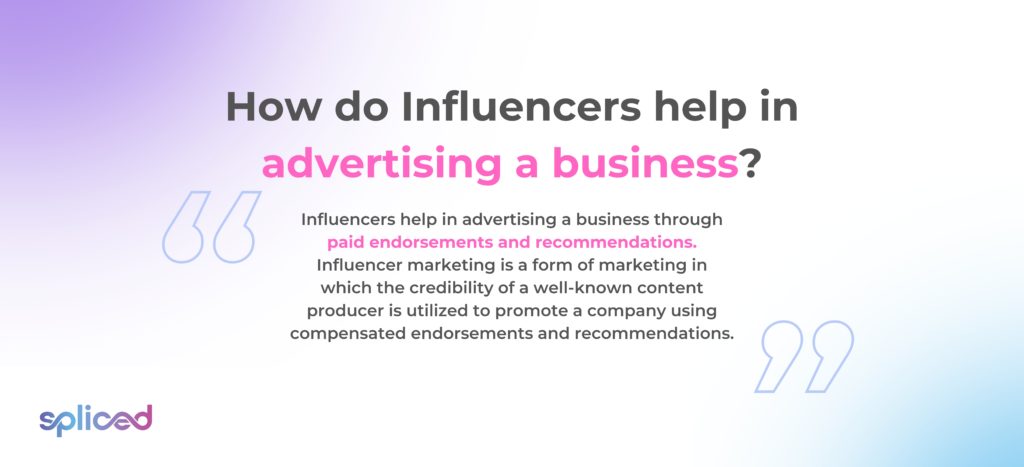
How do Influencers help in advertising a business?
Influencers help in advertising a business through paid endorsements and recommendations. Influencer marketing is a form of marketing in which the credibility of a well-known content producer is utilized to promote a company using compensated endorsements and recommendations.
An individual gains direct access to a sector of prospective customers who require and want to purchase a product when they form a partnership with an influencer. It’s not as simple as clicking the “like” button or sharing photographs. Imagine a brand advocate willing to endorse a product to thousands of their closest friends. That is what influencer marketing is. Customers are more inclined to purchase the things in question. It is especially true with clothing when customers witness their favorite content creators using a new face cleanser or wearing trendy apparel.
There needs to be more clarity about how to make use of influencer marketing and how it is advantageous to the company because it is still a digital marketing channel that is relatively young. Find the answers to the questions and discover how influencers expand their company’s audience, the number of people who follow one on social media, and the number of visitors who visit the website.
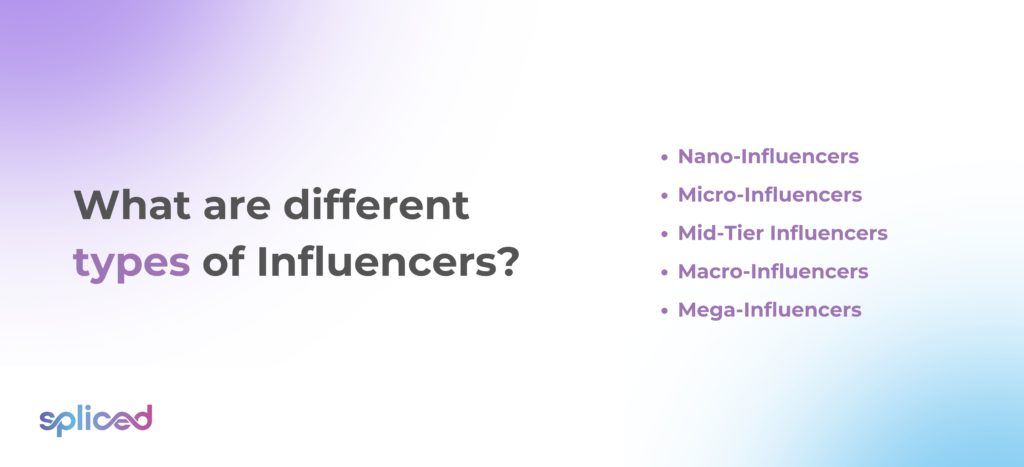
What are different types of Influencers?
The different types of Influencers are listed below.
- Nano-Influencers: Nano-Influencers usually have a social media following of 1,000 to 10,000 people. They have the highest engagement rates in the group of influencers.
- Micro-Influencers: Micro-influencers have a social media following of 10,000 to 100,000 followers. The intimacy of micro-influencers relationships with their audiences fosters trust and authenticity in their content.
- Mid-Tier Influencers: Mid-tier influencers have 60,000–200,000 followers, positioning them between micro and nano-influencers and macro and mega-influencers.
- Macro-Influencers: Macro-influencers are individuals who have between 100,000 and 1,000,000 followers across all of their social media channels.
- Mega-Influencers: A mega influencer is a social media personality who has amassed a massive online following, often in millions. These types of influencers are mostly actors, athletes, and other well-known celebrities.
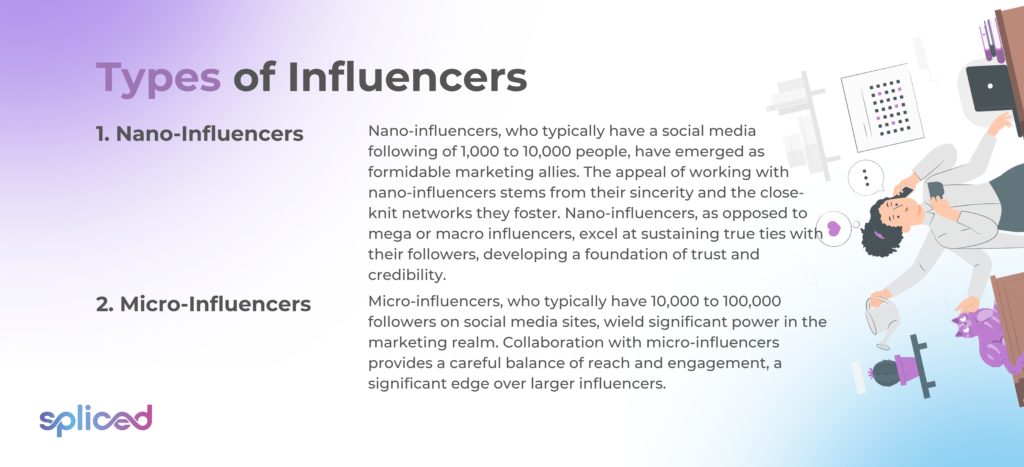
1. Nano-Influencers
Nano-influencers, who typically have a social media following of 1,000 to 10,000 people, have emerged as formidable marketing allies. The appeal of working with nano-influencers stems from their sincerity and the close-knit networks they foster. Nano-influencers, as opposed to mega or macro influencers, excel at sustaining true ties with their followers, developing a foundation of trust and credibility. These influencers come from a variety of backgrounds, including beauty lovers who provide honest product evaluations, fitness advocates who document their fitness journeys, and even local culinary bloggers with large followings in specific cities.
Nano-influencers thrive in industries where personal recommendations have a large influence, such as firms with specialty offers or localized services. An individual must be genuine in sharing experiences and thoughts, active involvement with their audience, and constantly content aligned with their specialization to be a successful nano-influencer. The high level of interaction is one of the most compelling reasons to collaborate with nano influencers. Nano influencers had an average engagement rate of 8.2% according to a Later study.
Nano-influencers typically charge lower costs, ranging from free product swaps to a few hundred dollars for each post. A nano-influencer makes $195 per post on Instagram on average, according to Statista. Platforms such as Instagram, Twitter, and TikTok are used to find nano-influencers by utilizing certain hashtags and searches. The benefits of working with nano-influencers include their low cost and authenticity, which fosters true brand advocacy. However, drawbacks include a very restricted reach and the possibility of inconsistent material quality due to varied levels of skill.
Nano-influencers frequently produce high conversion rates, despite these disadvantages by powerfully resonating with their engaged audience, resulting in average impressions ranging from a few hundred to several thousand, depending on the influencer’s following size and engagement levels.
2. Micro-Influencers
Micro-influencers, who typically have 10,000 to 100,000 followers on social media sites, wield significant power in the marketing realm. Collaboration with micro-influencers provides a careful balance of reach and engagement, a significant edge over larger influencers. Micro-influencers, as opposed to macro-influencers, build an intimate relationship with their audience, encouraging trust and authenticity in their material.
Micro-influencers come in a variety of forms, ranging from lifestyle and fashion bloggers to tech aficionados and wellness advocates. They include individuals passionate about specialized hobbies or professionals who share their expertise in specific areas. Micro-influencers are ideal for brands seeking a harmonious balance of reach and engagement, and they are especially beneficial for products or services with a larger target audience. Aspiring micro-influencers increase their reach by focusing on a specialized niche, producing high-quality, visually appealing content, and actively connecting with their fans.
Working with micro-influencers is often less expensive than working with macro-influencers, with prices ranging from a few hundred to a couple of thousand dollars for each post. Micro-influencers are found through social media platforms such as Instagram, Twitter, YouTube, and TikTok, as well as through influencer marketing services that connect firms with suitable micro-influencers. Micro-Influencers have a 5.3% engagement rate.
Working with micro-influencers provides a balanced mix of reach and meaningful engagement, building a genuine connection with their followers. However, potential drawbacks include higher expenses than nano-influencers. Micro-influencers, with their engaged and trusted audience, often provide outstanding conversion rates, and their average impressions range from tens of thousands to a few hundred thousand, depending on the size of their following and level of involvement.
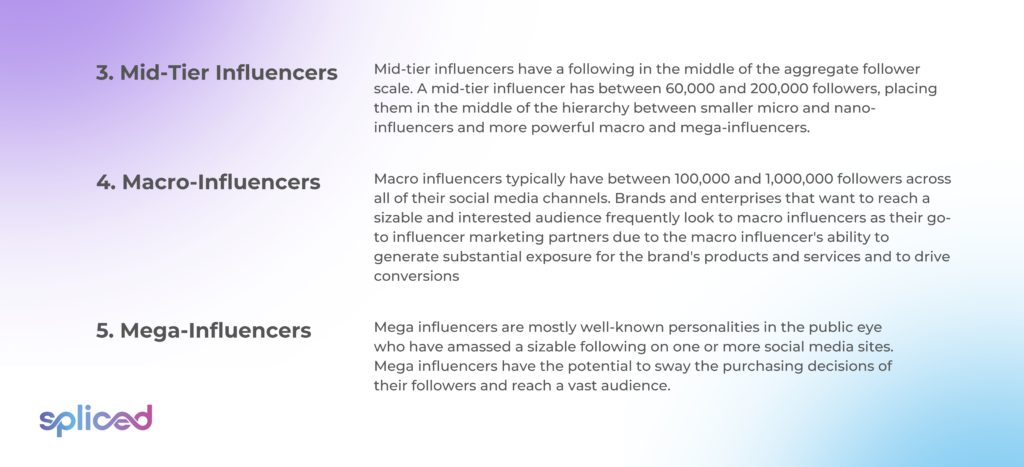
3. Mid-Tier Influencers
Mid-tier influencers have a following in the middle of the aggregate follower scale. A mid-tier influencer has between 60,000 and 200,000 followers, placing them in the middle of the hierarchy between smaller micro and nano-influencers and more powerful macro and mega-influencers.
Professional influencers are oftentimes content creators at the mid-tier level. A mid-tier influencer normally have several brand collaborations, sponsored posts, and affiliate marketing agreements under their belt, making it their primary source of income.
The effectiveness of mid-tier influencers lies in their optimal follower count, making them versatile assets in influencer marketing endeavors. Their intermediate audience size positions them ideally for a spectrum of promotional activities, encompassing social media takeovers, freebies, raffles, and the creation of product demonstrations and reviews. The unique advantage of collaborating with mid-tier influencers lies in their ability to engage a substantial audience while preserving the authenticity and trustworthiness typically associated with smaller influencers. Their followers often align closely with specific demographic targets, rendering them valuable for brands seeking precision in their marketing efforts. They offer a cost-effective solution compared to their macro-influencer counterparts while still delivering a substantial and engaged viewership.
Mid-level influencers have many benefits, but they have some drawbacks as well, such as higher prices compared to micro-influencers. These influencers may not offer the same amount of personal connection seen in their smaller analogues. These drawbacks, however, need to be viewed from the viewpoint of influencer marketing as a whole. Mid-tier influencers are used by brands to achieve a happy medium between a large audience reach substantial audience engagement, and reasonable campaign costs. Statista reports that the average income for mid-tier influencers per Instagram post is $1,221.
4. Macro-Influencers
Macro influencers typically have between 100,000 and 1,000,000 followers across all of their social media channels. Brands and enterprises that want to reach a sizable and interested audience frequently look to macro influencers as their go-to influencer marketing partners due to the macro influencer’s ability to generate substantial exposure for the brand’s products and services and to drive conversions. There’s a chance they have connections to other influencers and brands, allowing them to work together on cross-promotional material and campaigns.
Fashion, beauty, lifestyle, and fitness are common specialties of macro influencers. High-quality material, creative hashtag use, and audience participation develop their followings. They are trusted and authoritative voices in their communities and influence their followers’ trends, opinions, and habits.
Explore Instagram, YouTube, and Twitter for macro-influencers with enormous followings. Influencer marketing platforms that connect brands and influencers are popular. Brands find industry influencers using search filters. Attending industry events, seminars, and networking events reveal macro influencers.
It takes careful planning to rise to the level of a macro-influencer. The first step for those who want to become macro influencers is to find a certain field or subset of that field in which they excel. Maintaining a huge audience requires constant production of high-quality, interesting material. A sense of community and connection is fostered through comments, direct messaging, and live sessions with followers. Increased exposure and a larger following are achieved through partnerships with other thought leaders, active participation in industry trends, and smart use of social media features. Someone needs patience, consistency, and honesty to become a macro influencer. A macro-tier influencer makes $1804 per post on Instagram on average, according to Statista.
5. Mega-Influencers
Mega influencers are mostly well-known personalities in the public eye who have amassed a sizable following on one or more social media sites. Mega influencers have the potential to sway the purchasing decisions of their followers and reach a vast audience.
Mega influencers are highly sought after by brands for influencer marketing in the form of endorsement deals and sponsored content collaborations because of their huge fan bases. They command hefty sums to spread the word about a product or service among their fan base, and their support does wonders for a company’s reputation. However, some consumers have become more wary of endorsements and are less willing to accept suggestions from big influencers as the prevalence of sponsored content increases.
Individuals often combine content creation abilities, distinctive personal branding, and strategic social media presence to reach mega-influencer status. They partner with major companies, take part in paid influencer marketing initiatives, and promote goods and services to their enormous fan base. They are valuable allies for businesses looking to expand their customer base because of the significant influence their suggestions and endorsements have on the visibility and sales of a brand.
Some of the most influential people in the world are well-known internet personalities. The established notoriety serves them well as they take on the position of super influencer. Kylie Jenner is one of the most famed examples of a mega influencer.
Despite these reservations, mega influencers continue to have a significant impact in the field of social media advertising. Brands that want to boost their profile and sales benefit significantly from their capacity to attain a wide audience and sway customer decisions. Mega-influencers have an average engagement rate of 2.72%.
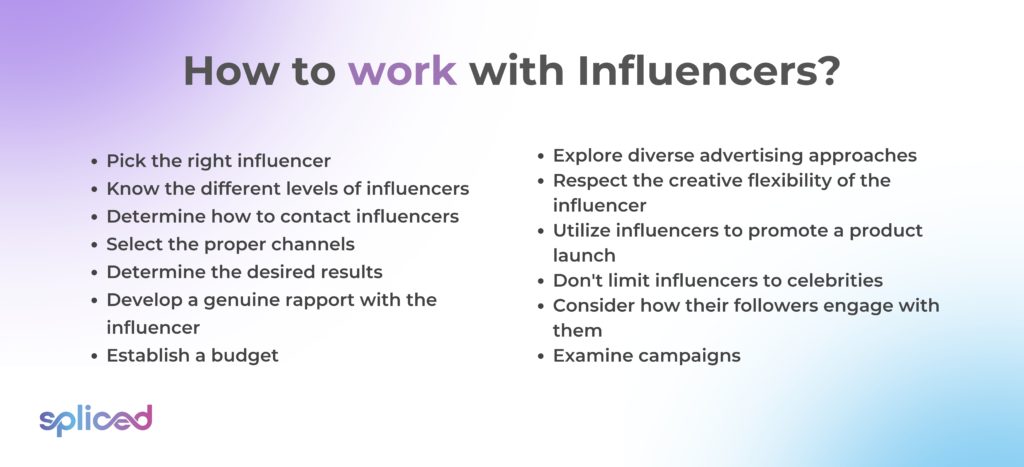
How to work with Influencers?
To work with influencers, follow the steps below.
- Pick the right influencer. Choosing the correct one is crucial to influencer marketing, given the diversity of influencers with different styles, audiences, and platforms. Aligning the influencer with a company’s goals is crucial. Influencers who share the brand’s beliefs, interests, and followers are more effective. Assessing the influencer’s engagement rates, audience fit, social media reach, authenticity, content consistency, and quality is crucial to choosing the proper pick. Influencers must distinguish between real and phony followers to maintain credibility and impact on the target audience.
- Know the different levels of influencers: Understanding the different levels of influence and what they accomplish for a company is an integral part of selecting the proper influencer for a business. One example is more prominent influencers, with more money but more potential customers. An organization gets more for its money if it targets a smaller, more niche audience. It’s possible that the company’s goals affect which choice they’d like you to make.
- Determine how to contact influencers: Many influential people have various preferred methods of interaction. Contact an influencer personally or through an agency on behalf of the firm. Business contacts with influencers often involve email. Direct communication on their platforms is common.
- Select the proper channels: Certain social media sites encourage more audience interaction, making influencer marketing more effective. It makes choosing the right social channels for the business vital for brand success. A video influencer has the opportunity to demonstrate product use and results if one owns a beauty brand. Use an older platform to market to 40-year-olds. Choose an influencer depending on where your audience spends the most time and has the best engagement.
- Determine the desired results: It’s important to have clear goals in mind before beginning to work with influencers. For instance, enlisting the help of an influential person with a sizable fan base has positive results in raising brand awareness. A highly engaged influencer is more cost-effective if direct sales are your goal.
- Develop a genuine rapport with the influencer: Strengthening collaboration requires establishing genuine connections with key opinion leaders. The more individuals network with influencers, the more access they have to their respective audiences. Influencers are more willing to do so if they see that brand owners are serious about promoting their work. Establish an open communication channel with them to ensure an influencer’s product promotion is in line with the company’s standards. New advertising methods and approaches are conceived through consistent dialogue with key opinion leaders.
- Establish a budget: Influencer’s fees vary widely Since most of them are self-employed, and there are no industry norms. Setting a budget helps in choosing cost-effective influencers. Ask many influencers for post and video prices. Compare influencers by influence, experience, follower engagement, and reach. It helps individuals choose influencers within a company’s budget.
- Explore diverse advertising approaches: Adapting to shifting audience tastes and preferences is an ongoing process for influencer efforts. Explore a variety of advertising methods to zero in on what works best for your business. Free samples are offered in exchange for an unbiased review, for instance. Pay for a sponsored article or hold a contest to determine which influencer generates the most sales. Always keep an eye on the metrics that matter for analysis and conversion tracking.
- Respect the creative flexibility of the influencer: It’s not uncommon for influential people to have a distinct persona that draws in their target demographic. Allowing influencers to keep some creative license in how they provide material is generally advantageous, even while some control is necessary to ensure consistency with company branding. Be receptive to their ideas and methods of persuasion if aiming to be more genuine and give their audience what they want. Influencers know best when it comes to the tastes of their followers.
- Utilize influencers to promote a product launch: Think about using key opinion leaders to help spread the word about your brand-new product or service. Have them attend product launches and other sponsored events, and then invite them to share their experiences on social media. Such a tried-and-true method of advertising does wonders for your company’s bottom line.
- Don’t limit influencers to celebrities: Many people wrongly believe that famous people make good brand ambassadors. Do not expect a guaranteed return on investment when you pitch your business to celebrities with millions of followers. Using well-known and respected members of your target audience boosts the campaign’s success. For instance, individuals find it more effective to collaborate with a regional influencer than with an internationally recognized one since the former is more likely to have a receptive audience in the area of focus.
- Consider how their followers engage with them: The number of a person’s followers isn’t always indicative of how influential they are. Only a fraction of that number is actually paying attention, even if an influencer has a million followers. Evaluate how well they interact with their target audience before selecting an influencer for a campaign. Examine the number of individuals who like and comment on an influencer’s posts, as well as their demographics.
- Examine campaigns: Reviewing consumer data after a marketing campaign in which an influencer was involved is helpful. Return on investment, cost per win, cost per lead, and cost per conversion are just a few of the major performance measures used to evaluate the efficacy of a campaign. Use trackable links to get a clearer picture of how an influencer’s audience interacts with their content. Learn more about the influencer’s audience and the efficacy of their postings with the information. Get a clearer picture of the campaign’s cost-effectiveness by comparing any meaningful uptick in income to the costs of engaging an influencer.
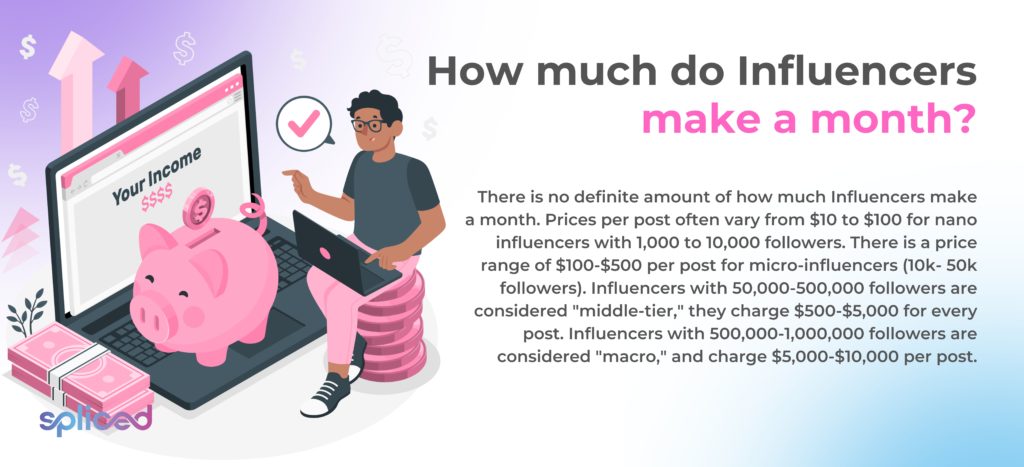
How much do Influencers make a month?
There is no definite amount of how much Influencers make a month. Prices per post often vary from $10 to $100 for nano influencers with 1,000 to 10,000 followers. There is a price range of $100-$500 per post for micro-influencers (10k- 50k followers). Influencers with 50,000-500,000 followers are considered “middle-tier,” they charge $500-$5,000 for every post. Influencers with 500,000-1,000,000 followers are considered “macro,” and charge $5,000-$10,000 per post. Superstars with a million or more fans charge upwards of ten grand for each of their social media updates. The going rate is often around $100 per 10,000 followers.
A thorough framework for estimating the overall rate is found in the calculation of $100 per 10,000 followers, in addition to considerations for the number of posts and extra criteria like expenses for the shoot, usage, or exclusivity. Another method for approximating an influencer’s rate is dividing their total number of followers by 4% before factoring in the frequency of their posts and other variables.
Influencer rates differ since TikTok is newer than Instagram. TikTok post costs vary by influencer tier. Nano influencers with 1,000–10,000 followers earn $800 for every post. Mid-tier influencers (50,000–500,000 followers) charge $3,000 per post, while micro-influencers (10,000–50,000 followers) ask for payment $1,500. Macro influencers (500,000–1,000,000 followers) ask $5,000 for each post. TikTok posts by 1,000,000-follower mega influencers cost $7,000 or more. TikTok’s culture and user participation shape its fee structures.
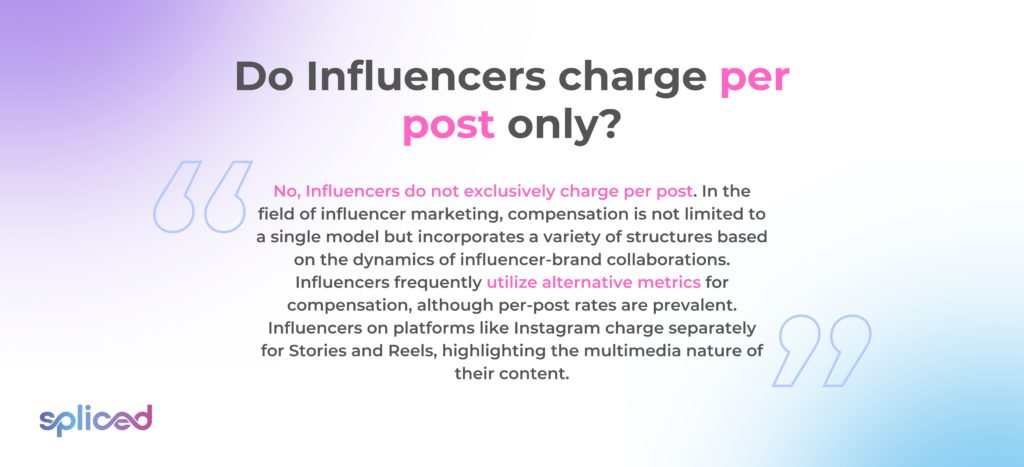
Do Influencers charge per post only?
No, Influencers do not exclusively charge per post. In the field of influencer marketing, compensation is not limited to a single model but incorporates a variety of structures based on the dynamics of influencer-brand collaborations. Influencers frequently utilize alternative metrics for compensation, although per-post rates are prevalent. Influencers on platforms like Instagram charge separately for Stories and Reels, highlighting the multimedia nature of their content. They set rates based on individual videos on YouTube or TikTok, which reflect the amount of time spent creating and promoting each piece.
Some influencers elect for a comprehensive per-campaign fee, which encompasses multiple posts, stories, and diverse content elements over a predetermined time frame. Performance-based compensation models link the earnings of influencers to campaign metrics such as engagement rates and sales generated. Long-term partnerships introduce the prospect of monthly retainers or annual contracts, fostering enduring collaborations and mutual dedication. The diversity of influencer compensation structures highlights the preferences of influencers, the strategic objectives of brands, and the dynamic nature of influencer-brand relationships.
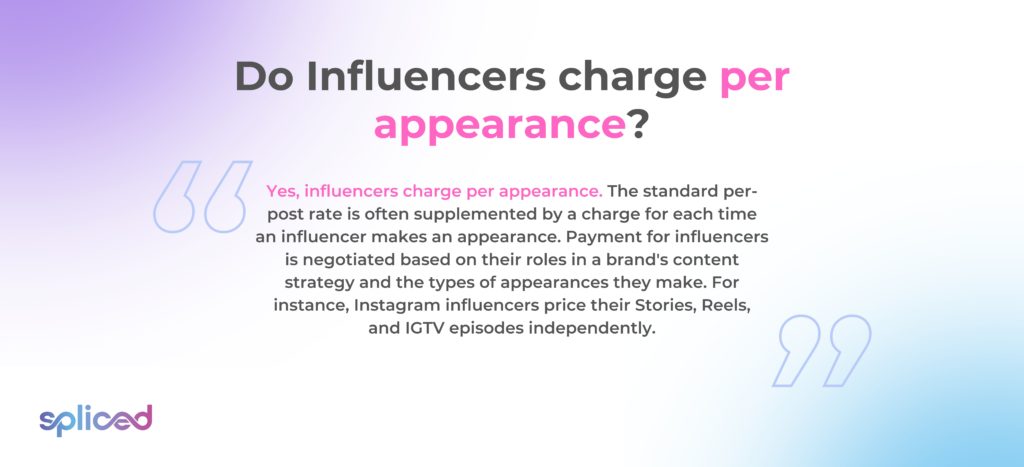
Do Influencers charge per appearance?
Yes, influencers charge per appearance. The standard per-post rate is often supplemented by a charge for each time an influencer makes an appearance. Payment for influencers is negotiated based on their roles in a brand’s content strategy and the types of appearances they make. For instance, Instagram influencers price their Stories, Reels, and IGTV episodes independently. Influencers set their own prices for any video they make on YouTube or TikTok. Some choose to be paid for the entire campaign rather than receiving payment for each individual post, story, video, or other form of material produced by an influencer. Indicators like as engagement, click-through rates, and sales generated factor into performance-based incentive plans. Influencers require a monthly retainer or yearly contract fee for extended collaborations. The various payment options are designed to meet the varying requirements of both influencers and companies.
How to become an Influencer?
To become an influencer, follow the steps listed below.
- Find a field of know-how. Discover one’s interests first. Be it related to sports, fashion, technology, the arts, or fitness. Differentiate oneself from other thought leaders by developing expertise in a subset of the favored field.
- Determine the topic of expertise. Discover personal interests first. Is it food, technology, recreation, health, or another topic? Carve out a niche within one’s passion to differentiate from other influencers.
- Develop a content strategy. Select the appropriate platform(s) to reach them once the target audience is identified. It is simple to see why Instagram is one of the most renowned platforms for influencers and brands.
- Distribute the content. A material serves little use without an audience to view and engage with. Meticulously plan when one publishes and distribute their social media content. The optimal moment to publish content on social media depends greatly on the social media channel chosen.
- Develop a website. Personal websites must always be an advocate irrespective of whether one uses Instagram, TikTok, Pinterest, or another social media site. Websites are great for SEO because they enable individuals to produce evergreen content with keywords that are optimized to rank at the top of search engine results pages (SERPs). Create content based on the topics and keywords the audience searches for, attracting them to the website.
- Stay current. Remain abreast of the newest trends and hottest topics as an influencer. Follow other content creators in your niche on social media, be aware of the latest hashtags and challenges, and be aware of the keywords the audience uses to search online. Remember that social media platforms frequently update their policies, algorithms, and posting terms; therefore, one must remain current to prevent the account from becoming irrelevant or, worse, deleted.
- Being oneself. Remember that authenticity is essential to being an effective influencer. Almost 70% of marketers agree that “authenticity and transparency” are crucial for effective influencer marketing.
- Engage with a target audience. Take time to answer followers’ questions and comments on your postings. Make them feel appreciated. It helps build a bond with them. Some comments and inquiries are going to be negative usually. Anticipate criticism and unfavorable remarks as an influencer. Maintain composure and confront them professionally.
- Connect with other influencers. Collaborate with other niche influencers to develop the audience and network. Discover potential collaborators via social media, online communities, and conventions and events. Having business cards to hand out to prospective collaborators is beneficial.
- Make a media kit and pitch it to brands. A media kit is an influencer’s CV or portfolio. An influencer media kit describes someone’s work, successes, audience, and why businesses must collaborate with them. Every influencer must email marketing experts, brand reps, and agencies a media kit to obtain business. Personal kit’s design must reflect individuality because personality is crucial. Media kits boost professionalism. Many people start influencing and producing content for fun. Media kits demonstrate to companies that someone is serious about their work.
- Maintain consistency. Followers must trust someone to post valuable stuff. They only follow or pay attention if influencers are consistent. Using social publishing tools to schedule posts helps one stay consistent. These tools let one produce, upload, and schedule articles in batches for their social network profiles. Utilizing these tools is one factor in how to become an influencer effectively.
- Keep track of one’s progress. Such a stage is vital if individuals want to work with businesses on influencer marketing campaigns, as it is one of the things brands look for in influencers. Most social media platforms provide demographics, reach, and engagement rate metrics to track audience growth. It shows people which content forms are most engaging, so they do more.
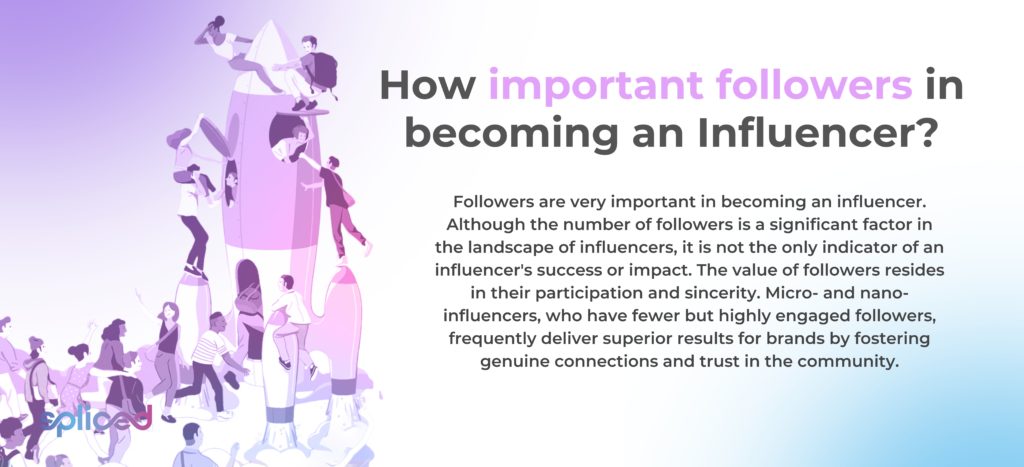
How important followers in becoming an Influencer?
Followers are very important in becoming an influencer. Although the number of followers is a significant factor in the landscape of influencers, it is not the only indicator of an influencer’s success or impact. The value of followers resides in their participation and sincerity. Micro- and nano-influencers, who have fewer but highly engaged followers, frequently deliver superior results for brands by fostering genuine connections and trust in the community.
The importance of the quality of the audience, their alignment with the influencer’s niche, and the level of interaction cannot be overstated. A smaller but more interactive and devoted following result in increased conversion rates and genuine brand advocacy. To establish a meaningful and influential presence in the competitive world of influencer marketing, however, aspiring influencers must strike a balance between quantity and quality of followers. In social media marketing, engagement rates are like gold.
Indeed, vanity metrics such as the number of followers or the number of impressions have some value. However, the amount of likes and comments provide context for your social media performance. A healthy engagement rate is between 1 and 5 percent, according to most social media marketing professionals, but it becomes increasingly challenging to attain with a growing number of followers.
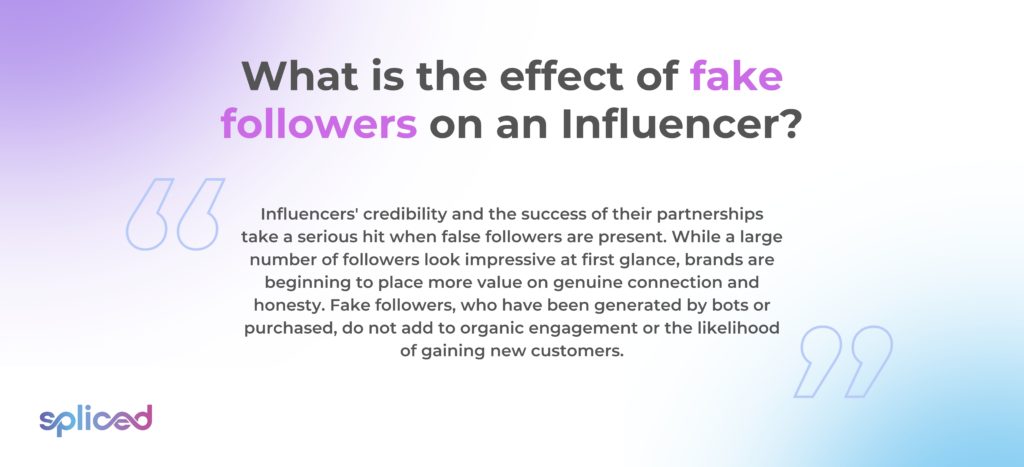
What is the effect of fake followers on an Influencer?
Influencers’ credibility and the success of their partnerships take a serious hit when false followers are present. While a large number of followers look impressive at first glance, brands are beginning to place more value on genuine connection and honesty. Fake followers, who have been generated by bots or purchased, do not add to organic engagement or the likelihood of gaining new customers. As a matter of fact, they skew engagement data, making it harder for brands to evaluate an influencer’s true reach and effect. A loss of credibility with both brands and real fans result from the exposure of an influencer’s use of phony followers. Maintaining credibility and cultivating fruitful, long-term partnerships with companies requires influencers to put their attention where it really counts: on growing a loyal, organic following.
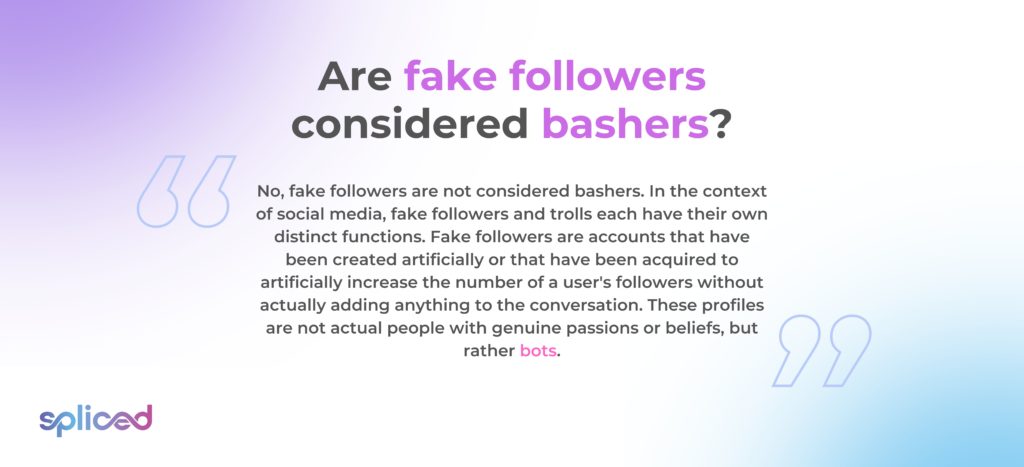
Are fake followers considered bashers?
No, fake followers are not considered bashers. In the context of social media, fake followers and trolls each have their own distinct functions. Fake followers are accounts that have been created artificially or that have been acquired to artificially increase the number of a user’s followers without actually adding anything to the conversation. These profiles are not actual people with genuine passions or beliefs, but rather bots.
Bashers, on the other hand, often known as online trolls, are those who spread hate speech or incite violence through social media. They write derogatory things, propagate misinformation, or purposefully start fights with other people.
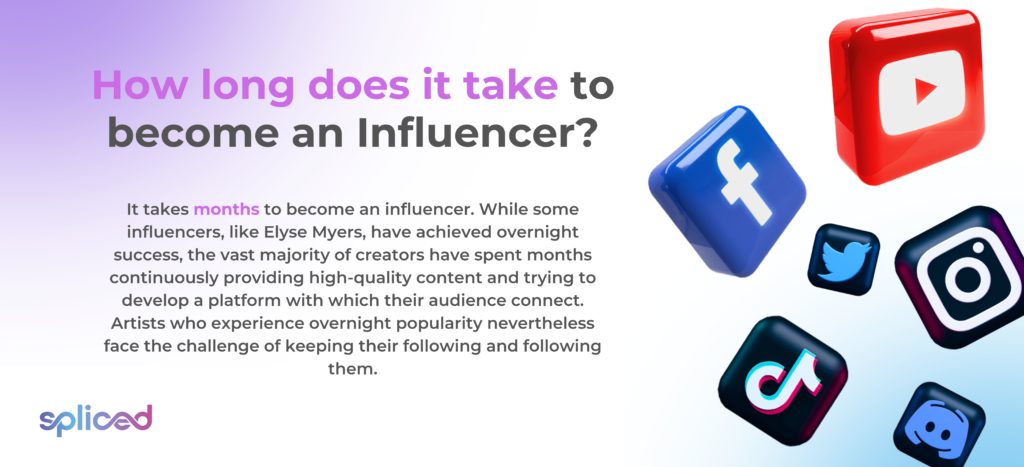
How long does it take to become an Influencer?
It takes months to become an influencer. While some influencers, like Elyse Myers, have achieved overnight success, the vast majority of creators have spent months continuously providing high-quality content and trying to develop a platform with which their audience connect. Artists who experience overnight popularity nevertheless face the challenge of keeping their following and following them.
It takes a year for influencers to see income from their social-media profiles and 18 months to develop a viable business, according to a new survey by The Tilt, a newsletter for content creators.
After only 4.9 months of content creation, the average influencer made a profit. However, it took the influencers 12.7 months to commit to a full-time business.
According to Business Insider, the average content producer fully sustain themselves with social media content after 18.4 months.
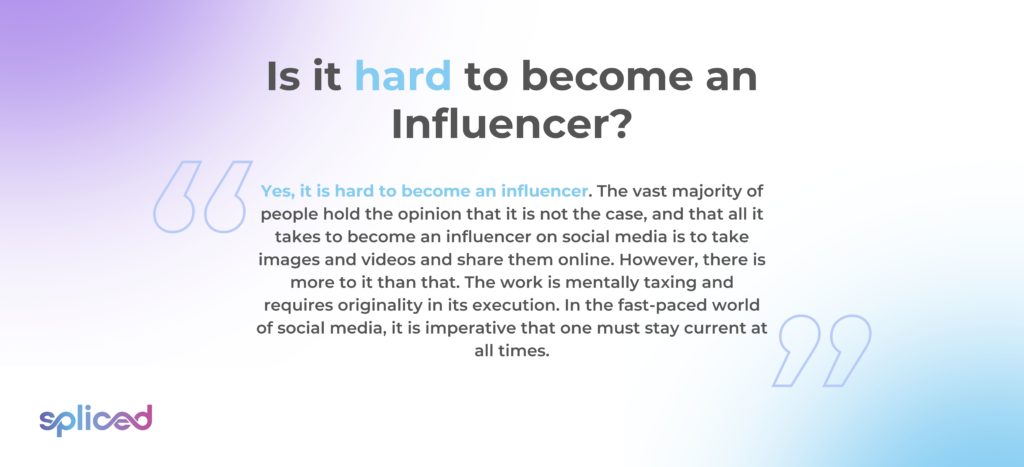
Is it hard to become an Influencer?
Yes, it is hard to become an influencer. The vast majority of people hold the opinion that it is not the case, and that all it takes to become an influencer on social media is to take images and videos and share them online. However, there is more to it than that. The work is mentally taxing and requires originality in its execution. In the fast-paced world of social media, it is imperative that one must stay current at all times.
Depending on topic, content quality, consistency, and audience engagement, influencership is complex but beneficial. Social media platforms have made it easier to join, but creating a large, engaged following takes time and strategy. It requires posting consistently, providing high-quality, authentic material that resonates with a target audience, and connecting with followers.
Influencers must develop a niche, follow trends, and react to social media algorithm adjustments. They must build a personal brand, work with other influencers, and handle digital marketing and sponsorships.
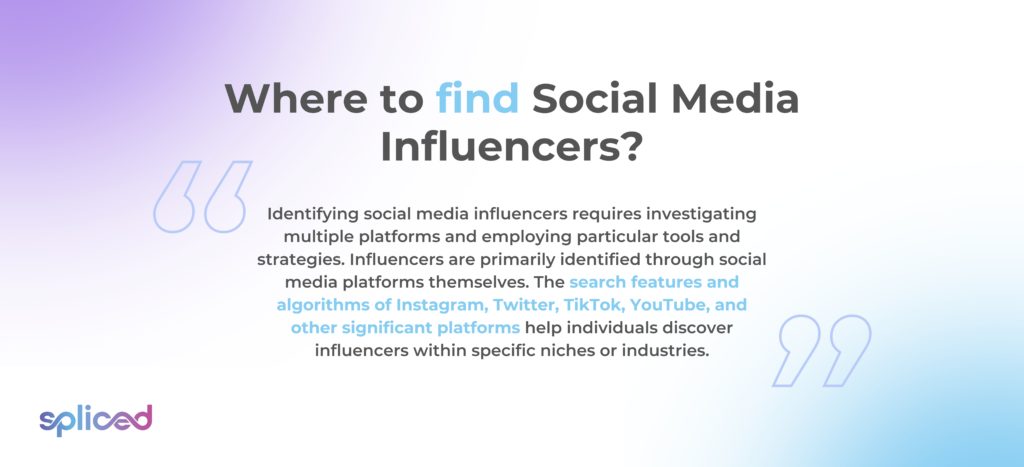
Where to find Social Media Influencers?
Identifying social media influencers requires investigating multiple platforms and employing particular tools and strategies. Influencers are primarily identified through social media platforms themselves. The search features and algorithms of Instagram, Twitter, TikTok, YouTube, and other significant platforms help individuals discover influencers within specific niches or industries. One of the best ways to find influencers is to look for trending hashtags relevant to a brand manually. Use Google in a variety of methods to find social media influencers. Google search alerts, for example, is software that allows you to establish alerts for brand-related keywords. It allows you to locate individuals who are discussing your brand, industry, niche, and everything else.
Influencer marketing platforms and agencies such as AspireIQ, Traackr, and Influencity are valuable tools for connecting brands with influential individuals. Hashtags and social listening tools enable you to monitor conversations and identify influencers pertinent to your brand or campaign. Attend industry-specific events, conferences, or webinars where influencers are present to facilitate direct connections. Collaboration with influencers whose values and target audience align with your brand’s is crucial, and meticulous research is required to ensure authenticity and alignment.
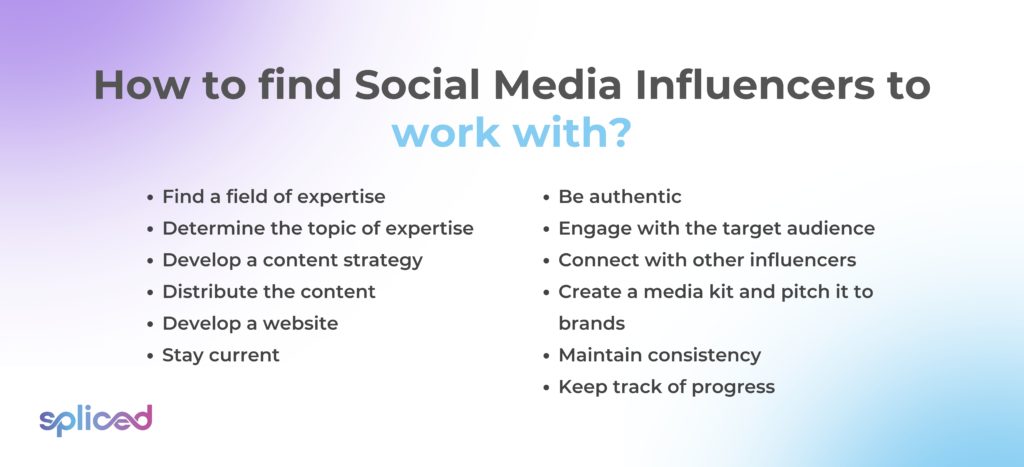
How to find Social Media Influencers to work with?
To find social media influencers to work with follow the steps listed below.
- Define the Goals: Clearly outline your campaign objectives, target audience, and the key performance indicators (KPIs) you want to measure.
- Understand Your Audience: Identify the demographics, interests, and preferences of your target audience to align with influencers who resonate with them.
- Utilize Influencer Platforms: Leverage influencer marketing platforms and tools like Traackr, Influencity, or AspireIQ to discover influencers within your niche.
- Social Media Platforms: Scout popular social media platforms such as Instagram, YouTube, Twitter, TikTok, and LinkedIn for influencers relevant to your industry.
- Keyword Searches: Use platform-specific hashtags, keywords, and searches to find influencers discussing topics related to your brand.
- Engagement Analysis: Evaluate influencer engagement rates, comments, and overall interaction with their audience to gauge authenticity.
- Check for Alignment: Ensure that the influencer’s values, content style, and audience align with the brand to maintain authenticity.
- Explore One’s Network: Tap into an existing network and industry connections for recommendations or collaborations with influencers. Having a vast network helps on how to find social media influencers.
- Collaborate on Content: Engage with potential influencers by commenting on their posts, sharing their content, or reaching out for collaboration opportunities.
- Negotiate Terms: Clearly define terms, compensation, and expectations before initiating a collaboration to avoid misunderstandings.
- Monitor Performance: Track the performance of influencer campaigns using analytics tools and adjust strategies based on insights.
- Build Long-Term Relationships: Cultivate long-term relationships with influencers for sustained brand advocacy and continued collaborations.
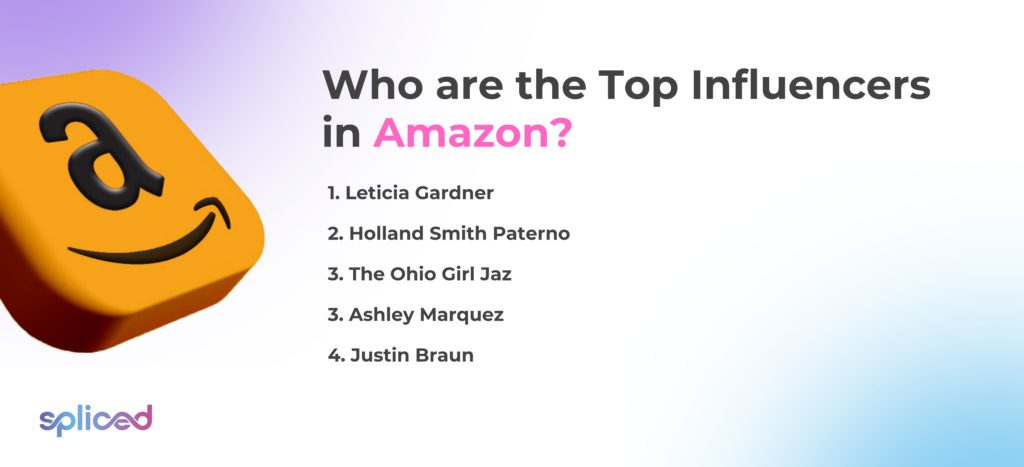
Who are the Top Influencers in Amazon?
The top influencers in Amazon are listed below.
- Leticia Gardner: Leticia Gardener is a multi-platform influencer who has amassed 1.7 million TikTok fans, 423,000 Instagram followers, and 14,000 YouTube subscribers. Leticia’s writing covers topics like health, style, family, and exercise. The Amazon influencer is the owner of Totalbody21, a fitness lifestyle firm, and the wife of former NFL player and influencer Rod Gardner. Leticia is among the top influencers on Amazon.
- Holland Smith Paterno: Blogger and fashion micro-influencer Holland Smith Paterno has 58k TikTok and 19.1k Instagram followers. Holland shares recommendations for fashion and leisure, such as recipes and Amazon’s “must-have” items. The Amazon influencer’s content is attractively styled with a distinct look, and her writing voice is polished without being stuffy.
- The Ohio Girl Jaz: Jaz has 39.7k followers on Instagram and a considerably lesser following on YouTube and TikTok, but the Amazon influencer is a fashion and beauty micro-influencer. Jaz’s attire is laid-back, inexpensive, and has a bohemian vibe. Jaz has collaborated with both large companies like Walmart and countless independent clothing stores. Ohio Girl Jaz often uploads video reviews and “Amazon hauls,” as well as exquisitely groomed and polished photographs, to Instagram.
- Ashley Marquez: One of the most influential people at Amazon is named Ashley Marquez. Marquez is an educator who writes on fashion, kids, and lifestyle in addition to innovative teaching and motivational material. Ashely is a macro-influencer and has 298k Instagram followers, 51k Facebook fans, and 41.7k Pinterest followers. Her taste is unpretentious and pure. Her writing largely consists of upbeat, inspiring lessons and advice for educators.
- Justin Braun: Justin Braun has 16.9K YouTube subscribers, 7k Facebook followers, and 3.8k Instagram followers. Justin writes energetically about off-roading, automotive mods, workshop tools, and tech. Videos promoting Amazon products drive traffic and sales to his Amazon associate partners.
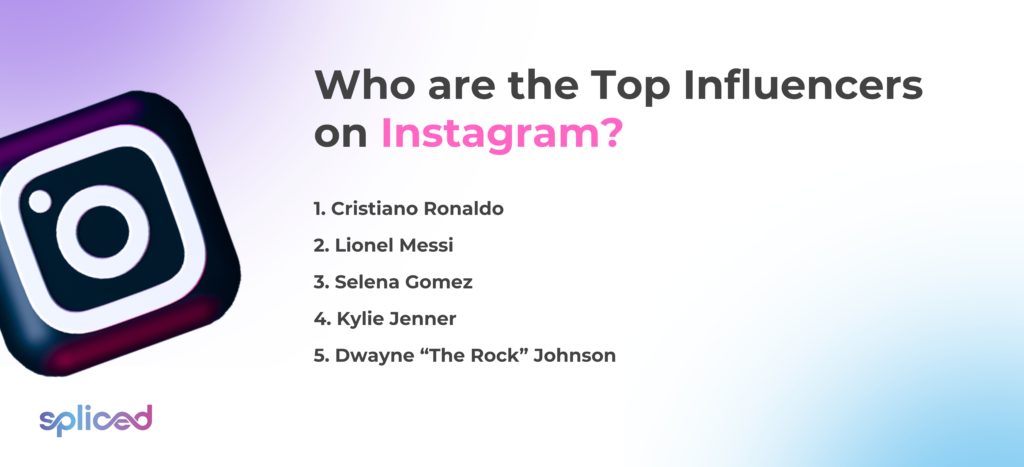
Who are the Top Influencers on Instagram?
The top influencers on Instagram are listed below.
- Cristiano Ronaldo: Cristiano Ronaldo has 607 million followers on Insatgram. The football star is the most followed individual on the social media platform. Ronaldo is known for being disciplined, committed, and generous. The football star is a widely recognized and marketable player due to philanthropic works and influence outside sports.
- Lionel Messi: Lionel Messi currently has 488 million followers on Instagram. Lionel Messi is largely considered to be among the sport’s all-time greats. Messi, who is renowned for having exceptional talent, vision, and goal-scoring prowess, has played for FC Barcelona for the bulk of the footballer’s career.
- Selena Gomez: One of the most followed individuals on Instagram is singer/actress Selena Gomez. Selena has 430 million followers on Instagram, gaining the pop singer as one of the top influencers on Instagram. American musician, actress, and producer who has found success in a variety of fields. Selena rose to fame at a young age thanks to the film Alex Russo on the Disney Channel series “Wizards of Waverly Place,” for which the singer-actress won multiple accolades and critical praise.
- Kylie Jenner: Kylie Jenner made history by reaching 300 million Instagram followers faster than any other woman.The youngest “self-made” billionaire in 2019, per Forbes in 2019 is undoubtedly more impressive. The Kylie Jenner empire keeps growing: Kylie Cosmetics, Kylie Skin, Kylie Swim, Kylie Baby, and more.
- Dwayne “The Rock” Johnson: Dwayne Johnson has 392 million followers on Instagram. The Rock, former WWE champion, movie actor, tequila mogul, and (potential) presidential candidate, comes in at number six on the most followed individuals on Instagram. The Rock’s ever-growing fan base are attributed to the actor’s upbeat, inspirational, and occasionally tequila-laced feed.
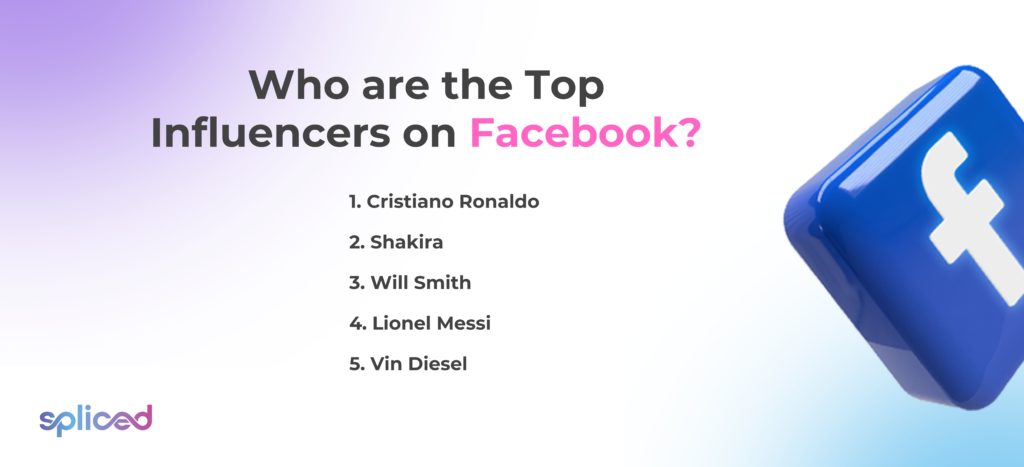
Who are the Top Influencers on Facebook?
The top influencers on Facebook are listed below.
- Cristiano Ronaldo: One of the most popular athletes on Facebook, Cristiano Ronaldo has 161 million followers, making the footballer one of the most popular athletes overall. The Portuguese professional footballer is known for having an excellent skills on the field, and off the field, Ronaldo is known for having an impressive fashion sense.
- Shakira: The Colombian singer and composer is famed for her one-of-a-kind and strong voice; she has over 125 million recordings sold all over the world and has received a number of awards. Her following currently stands at 121 million.
- Will Smith: Will Smith, an American actor, producer, and rapper, has 114 million followers. Will’s acting appearances in “Men in Black” and “The Pursuit of Happiness” helped propel the actor to fame. Will Smith has a successful music career and a large online following.
- Lionel Messi:The Argentine professional footballer has 113 million fans since Messi is considered one of the best players of all time. Messi has won a slew of honors for the athlete’s on-field prowess and off-field philanthropy.
- Vin DIesel: Vin Diesel, an American actor and producer, has 106 million followers on Facebook. The actor is best recognized in the “Fast and Furious” trilogy, as well as for the actor’s work behind the scenes as a producer and director. Diesel’s performances in the franchise have garnered the actors widespread recognition. Vind Diesel is among the top influencers on Facebook.
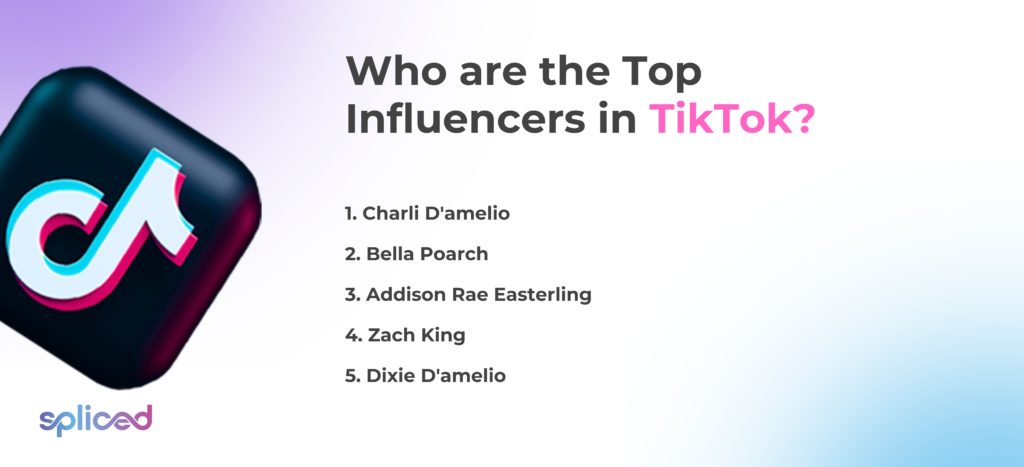
Who are the Top Influencers in TikTok?
The top influencers on TikTok are listed below.
- Charli D’amelio:Connecticut-born Charli D’amelio is TikTok’s top influencer. She became famous after sharing TikTok dance videos to top songs in 2019. With nearly 150 million followers, she posts vlogs, sketches, and dancing challenges. Charli continued her TikTok success. Her perfume brand, EOS and Hollister sponsorships, Hulu originals, and music release are all hers. Fortune’s 40 Under 40 list included her as the youngest ever in 2020. Time 100 Next and Teen Vogue’s Young Hollywood Class of 2021 featured Charli. Wish to emulate Charli? Authenticity makes Charli appealing. TikTok influencers must be authentic and unapologetic. Content must be heartfelt, whether you’re making funny or educational films.
- Bella Poarch: Bella Poarch, a 25-year-old who was previously ranked third on most top TikTok influencer lists, has become incredibly popular on the app in a short amount of time. The first video Bella ever uploaded to TikTok was a lip sync to Millie B’s “M to the B,” and it went viral, launching her TikTok career. Over sixty million people liked the TikTok, making it the most popular TikTok ever. Bella not only uploads videos of herself lip-syncing, dancing, and showcasing her sense of style, but even cosplay videos and videos documenting her daily life. Bella’s new EP, Dolls, has helped her establish herself as a musician. As an added bonus, she has become one of the most popular users on the video-sharing app TikTok.
- Addison Rae Easterling: A TikTok top influencer list is incomplete without Addison Rae Easterling. The New York Times calls the Louisiana-based TikTok star one of the hottest social media stars. Her lip-syncing and dancing videos have garnered Addison a huge TikTok following. She formed The Hype House, a TikTok dancing trio with Charlie D’Amelio and Chase Hudson. The success of her TikTok account led to a contract with WME, sponsored post deals with American Eagle, a podcast (That Was Fun? With Addison & Sheri), and a movie role. Forbes called her a TikTok key influencer in August 2020. Addison succeeds via consistency and variation. The 22-year-old TikTok celebrity posts frequently and is active on many platforms, including Challenges and Live. She always has new content, giving her followers something to look forward to when they open the app.
- Zach King: Aged enough to remember Vine? If so, you know Zach King. Zach became famous on Vine before TikTok. Zach, a renowned TikTok influencer, is an adept at crafting illusions and fascinating films. Zach posts a variety of stuff on TikTok, making it distinctive. Zach surprises and delights his audience with humorous TikToks and high-production illusions. Zach is regularly recruited by brands to develop marketing content with over 70 million followers. What does Zach teach? Start by experimenting with TikTok effects and filters to make fascinating edits. To make your TikTok videos stand out, think of new methods to engage your audience and build a signature style.
- Dixie D’amelio: Dixie D’amelio is a popular TikTok influencer. Why? Of course she’s Charli D’amelio’s sister, the #1 TikTok influencer. Dixie won’t let her younger sister outshine her. As a musician and TikTok influencer, she’s sponsored by Hollister and Morphe. In June 2020, Dixie released her first single, “Be Happy,” and featured on Attaway General. Hulu’s The D’Amelio Show follows Charli, Dixie, their dad Marc, and their mother Heidi’s daily life. Having a renowned younger sister helps you become a TikTok influencer like Dixie. The D’amelios show how spreading one’s material on and off TikTok helps someone become long-term and top influencers on TikTok.
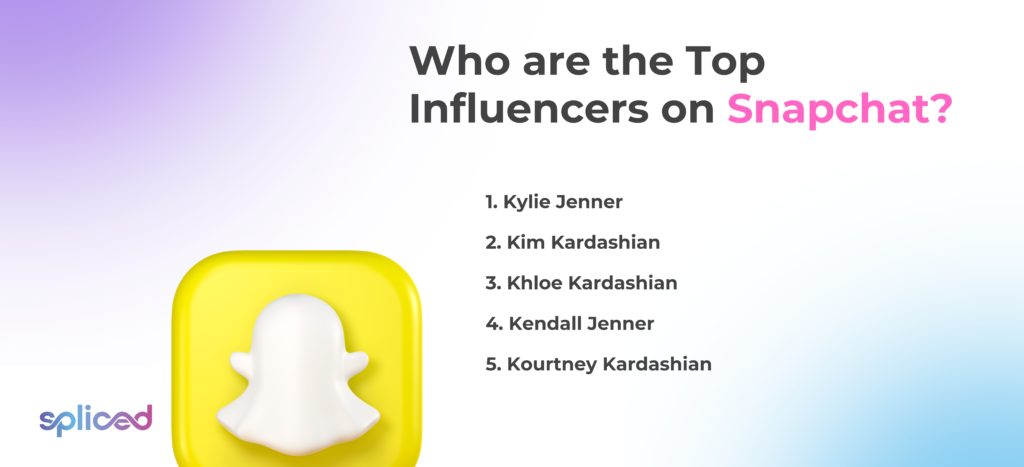
Who are the Top Influencers on Snapchat?
The top influencers on Snapchat are listed below.
- Kylie Jenner: Kylie Jenner is the most followed influencer on Snapchat, having 37 million subscribers. American businesswoman, socialite, and media personality Kylie Jenner was born in Los Angeles on August 10, 1997. The reality show “Keeping Up with the Kardashians,” which chronicled the family’s daily activities, helped propel her to stardom.
- Kim Kardashian: Second on the list of influencers having the most followers on Snapchat is Kimkardashian. Kim has 27.2 million followers on the social media app. Kim Kardashian rose to fame for having a scandalous personal life and relationships before making a mark in the beauty and fashion industries. The socialite has established a number of profitable enterprises, such as the apparel store DASH, a mobile game, and the cosmetics company KKW Beauty.
- Khloe Kardashian: Khloe Kardashian has 16.8 million followers on Snapchat. Khloé Kardashian lives have been extensively filmed on reality television, making the influencer a well-known figure in popular culture. Khloe has a large social media following and is well-known for the socialite’s support of body positivity and self-love.
- Kendall Jenner: Kendall Jenner has 16.7 million subscribers on snapchat. Kendall has moved into entrepreneurship in addition to the model’s successful modeling career. The model has worked with several brands and created own items. Kendall’s popularity extends to social media and has a large following and interacts with admirers.
- Kourtney Kardashian: Kourtney has 15 million subscribers on the social media app Snapchat. Kourtney has worked on a number of business projects in addition to the socialite’s part on the reality show. Kourtney is a co owner of the lifestyle brand called Poosh and co-owns the clothes store DASH. The reality star is an advocate for clean and organic living. The Kardashian sisters dominate the top influencers on Snapchat.
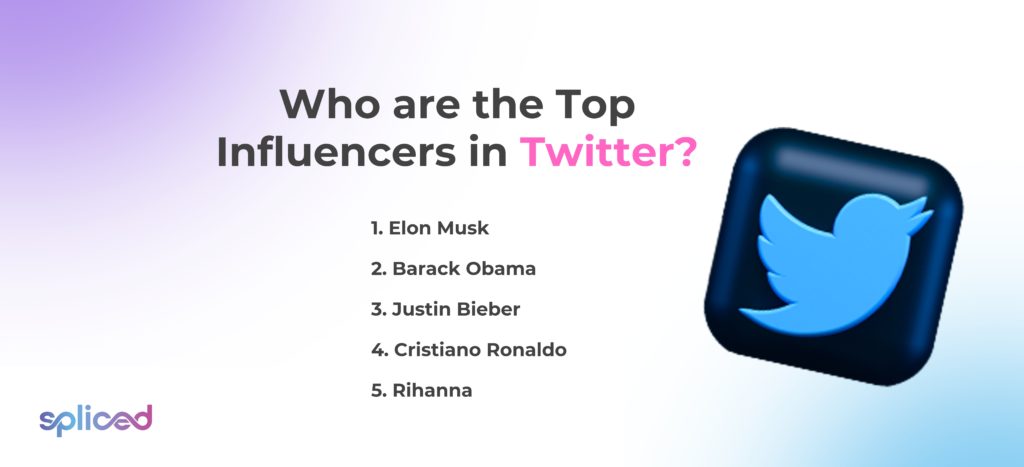
Who are the Top Influencers in Twitter?
The top influencers on Twitter are listed below.
- Elon Musk: Elon Musk is the owner of Twitter. Elon Musk happens to be the most-followed person on Twitter, with over 158 million followers. Musk knows more about how social media works and how people use it than any CEO of a social media firm.
- Barack Obama: The former U.S. president has over 131 million followers on Twitter. Barack is the most followed politician on Twitter.
- Justin Bieber: Over 111 million people are following the Canadian artist Justin Bieber (@justinbieber) on Twitter, making him the musician with the most followers overall.
- Cristiano Ronaldo: The Portuguese footballer Cristiano Ronaldo (@Cristiano) has more than 109 million followers on Twitter, making the footballer the most popular athlete in the world. Cristian
- Rihanna: Rihanna, a singer from Barbados, has over 108 million followers, making her the most followed woman on Twitter. The pop singer’s username is @rihanna. Rihanna is among the top influencers on Twitter.
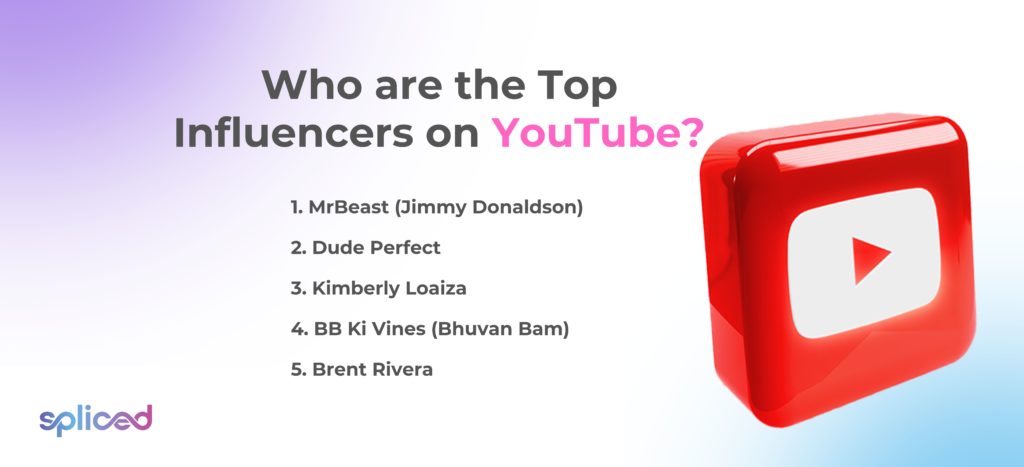
Who are the Top Influencers on YouTube?
The top influencers on YouTube are listed below.
- MrBeast: Jimmy Donaldson, or “MrBeast” is a model of how to construct an online empire through viral means. The 23-year-old began posting films to YouTube when he was still a teenager (6 years ago). MrBeast’s primary channel experienced a meteoric rise in subscribers after six years of trial and error, and it is now the fastest-growing channel on YouTube, with over 80 million members. The influencer opened MrBeast Burger in 2020, a viral burger franchise with outlets around the United States, and operates a retail store. The fact that he has a flawless Favikon score, an amazing buzz ratio, and an excellent engagement rate all point to the fact that he has incredibly supportive subscribers. His engagement rate is 3.67%. His videos never fail to leave an impression. Audiences are delighted by MrBeast’s work, which ranges from insane challenges such as “I didn’t eat food for 30 days” to epic videos such as “Would you swim with sharks for $100,000?”
- Dude Perfect: These groups of five pals are among the most popular content makers on the network, boasting a combined total of 58 million followers and an impressive engagement rate of 3.69%. They began uploading videos to YouTube in 2009, thus it is safe to assume that they have witnessed the platform’s development throughout the years. Their content is fairly varied, including comedic skits, challenges, and people experimenting with strange stuff…
- Kimberly Loaiza: With 37 million followers and an incredible engagement rate of 6.68%, it is clear that Kimberly Loaiza has mastered the art of producing high-quality films. She is well known for her videos on YouTube and a vocalist from Mexico. Kimberly’s YouTube channel, launched in 2016, amassed one hundred thousand subscribers in just one week. Most of Kimberly’s videos these days are family vlogs, but uploads personal music videos as well.
- BB Ki Vines: BB Ki Vines is an Indian musician, actor, and YouTuber known by the stage name Bhuva Bam. 2015 was the beginning of his career on YouTube. He is well-known for the video series that he created, which is about the lives of a teenager, including his friends and family. Bhuva is responsible for playing every single one of the roles. His channel currently has 25.5 million members and a high interaction rate of 8.66%, according to YouTube analytics.
- Brent Rivera: Brent Rivera is among the top influencers on Youtube from the United States who is 24 years old. It was on the social network Vine where he originally rose to prominence, but he has since established a sizable following on YouTube. His current subscriber count is 20.2 million, and his engagement rate is 6.62%, which is fantastic. The majority of the films Brent uploads are comedic in nature, with titles like “this is the most expensive first-class seat” and “my 30-day body transformation.”
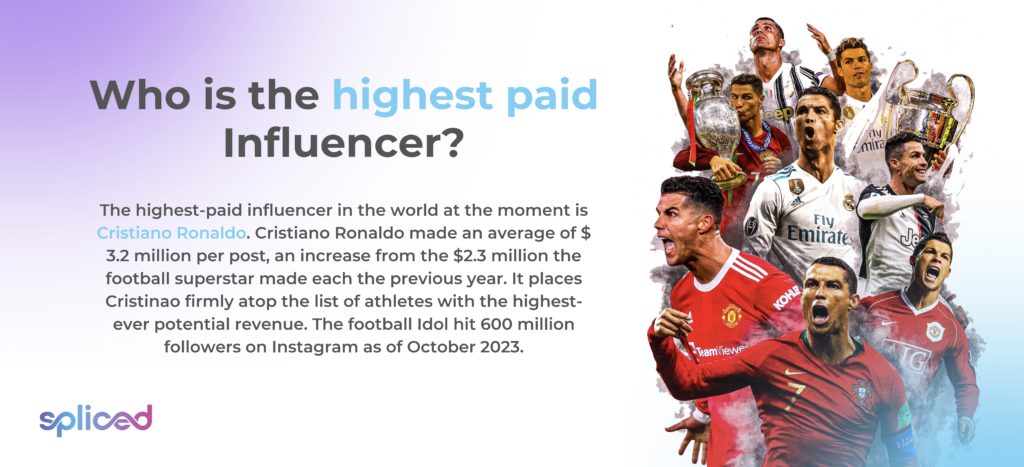
Who is the highest paid Influencer?
The highest-paid influencer in the world at the moment is Cristiano Ronaldo. Cristiano Ronaldo made an average of $ 3.2 million per post, an increase from the $2.3 million the football superstar made each the previous year. It places Cristinao firmly atop the list of athletes with the highest-ever potential revenue. The football Idol hit 600 million followers on Instagram as of October 2023.
Cristiano Ronaldo, who was born on February 5, 1985, in Funchal, Madeira, Portugal, is widely considered to be one of the best players of all time. Ronaldo has had an impressive career thanks to the footballer’s skill as a goal scorer, speed, and ability to play multiple positions.
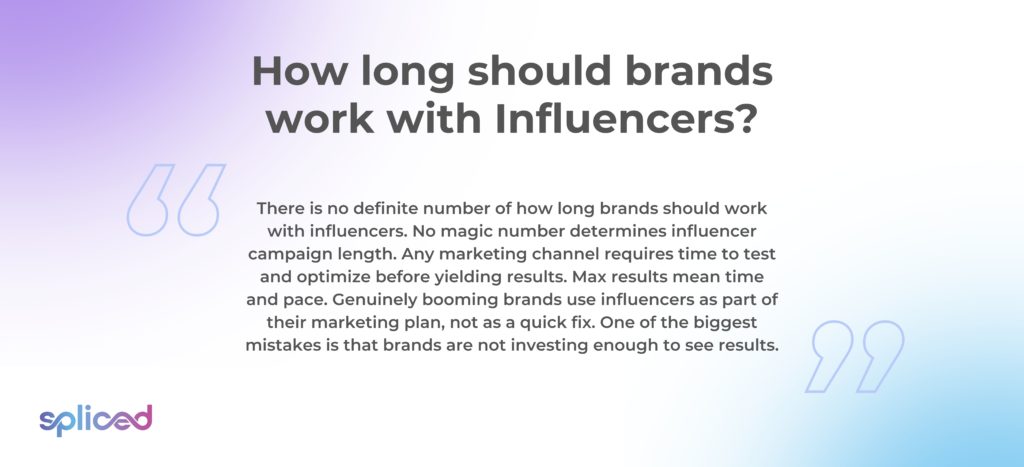
How long should brands work with Influencers?
There is no definite number of how long brands should work with influencers. No magic number determines influencer campaign length. Any marketing channel requires time to test and optimize before yielding results. Max results mean time and pace. Genuinely booming brands use influencers as part of their marketing plan, not as a quick fix. One of the biggest mistakes is that brands are not investing enough to see results. Throwing money at any strategy and expecting fast results is going to fail. Influencer campaigns, too.
Brands benefit from an “always-on” influencer strategy based on experience. Consider that 77% of brands budget on influencers. The amount of dedication is long-term, not reflexive. Consider continuous marketing channels like SEO or inbound. These strategies involve upfront time and ongoing tweaking. Creator campaigns grow steadily before scaling up. Always-on promotions yield long-term benefits. Influencer content, social proof, and sales help are included. Treating influencers like inbound or ad campaigns. Keep going if one’s efforts are yielding quality leads. Maintain momentum instead. Apply the same logic to influencer campaigns.
A typical influencer campaign timeline often spans several months to maximize effectiveness. The initial phase, around three months, is dedicated to testing various content types and promotional strategies to identify those that garner the highest engagement. There’s a six-month period focused on optimizing campaign messaging and refining the overall influencer marketing strategy based on the insights gathered. The long-term strategy unfolds over approximately a year, allowing sufficient time to achieve peak results in terms of engagement, brand awareness, and sales. The gradual approach acknowledges the need for experimentation, refinement, and sustained effort to realize the full potential of influencer partnerships.
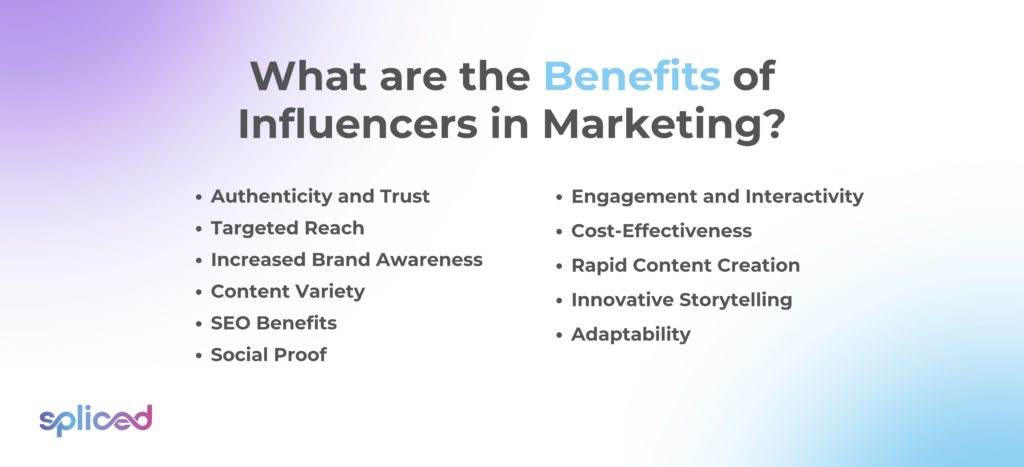
What are the Benefits of Influencers in Marketing?
The benefits of Influencers in Marketing are listed below.
- Authenticity and Trust: Influencers build genuine connections with their audiences over time. It often carries a level of trust that traditional advertising lacks when they endorse a product or service.
- Targeted Reach: Influencers often specialize in niche areas, allowing brands to target specific demographics. Its targeted approach ensures that the marketing message reaches an audience more likely to be keen on the product or service.
- Increased Brand Awareness: Leveraging the existing follower base of influencers exposes a brand to a broader audience. Increased exposure leads to higher brand awareness, especially among populations that are challenging to reach through traditional advertising.
- Content Variety: Influencers excel at creating diverse and engaging content. Brands tap into creativity to showcase their products or services in various formats, from images and videos to blog posts and live streams through collaborations.
- SEO Benefits: Collaborating with influencers positively impact a brand’s online presence. It contributes to improved search engine optimization (SEO) when influencers create content and link to a brand’s website or social media.
- Social Proof: People often make purchasing decisions based on the opinions and experiences of others. Positive endorsements from influencers serve as social proof, influencing the perceptions and choices of their followers.
- Engagement and Interactivity: Influencers often have high engagement rates on their content. Influencers enhance audience engagement and establish a sense of community around a brand by incorporating interactive elements such as polls, Q&A sessions, or giveaways.
- Cost-Effectiveness: Influencer marketing is cost-effective compared to traditional advertising. Collaborating with influencers offers a higher return on investment (ROI), particularly for small and medium-sized businesses.
- Rapid Content Creation: Influencers are adept at creating content quickly and consistently. The agility is beneficial for brands seeking to maintain a dynamic online presence and respond promptly to trends.
- Innovative Storytelling: Influencers are skilled storytellers. They craft narratives around a brand that resonates with their audience, creating a more emotional and memorable connection.
- Adaptability: Influencer marketing is adaptable to various platforms and formats, from Instagram and YouTube to podcasts and blogs. The versatility allows brands to customize their strategies to fit the preferments of their target audience.
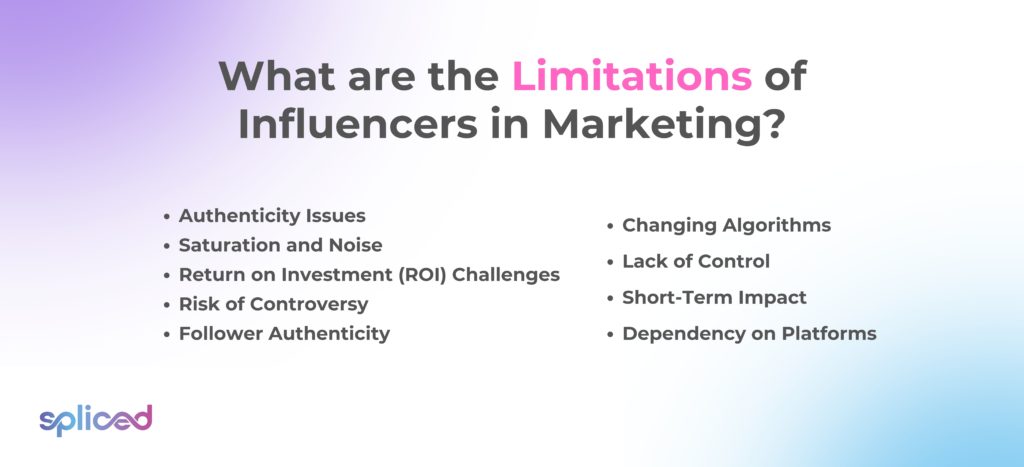
What are the Limitations of Influencers in Marketing?
The limitations of influencers in Marketing are listed below.
- Authenticity Issues: Some influencers have faced criticism for inauthenticity as the industry has grown. Audiences quickly discern when an influencer is not genuinely aligned with a product or service, leading to a loss of trust.
- Saturation and Noise: There’s a saturation of content with the rise of influencer marketing. The oversaturation leads to diminished impact, as audiences become desensitized to sponsored content or find it overwhelming.
- Return on Investment (ROI) Challenges: Measuring the direct impact and ROI of influencer marketing is challenging. Attribution of sales or conversions to a specific influencer’s efforts takes some work.
- Risk of Controversy: Influencers are individuals with personal lives, opinions, and behaviors. Brands face reputational risks if an influencer engages in controversial activities or expresses unpopular opinions.
- Follower Authenticity: Some influencers resort to buying followers to inflate their numbers. It misleads brands into partnering with influencers who need genuine engagement.
- Changing Algorithms: Social media platforms frequently update their algorithms, affecting the visibility of content. It impacts how many followers see an influencer’s posts, reducing the overall reach of a campaign.
- Lack of Control: Brands have limited control over the influencer’s content once they partner with an influencer. The final output is at the discretion of the influencer while guidelines are provided.
- Short-Term Impact: Influencer marketing is often more effective for short-term campaigns. Sustaining long-term relationships with influencers is challenging due to changing trends and audience interests.
- Dependency on Platforms: Influencers are often reliant on social media platforms. Changes to algorithms, policies, or the emergence of new platforms impact the effectiveness of influencer strategies.
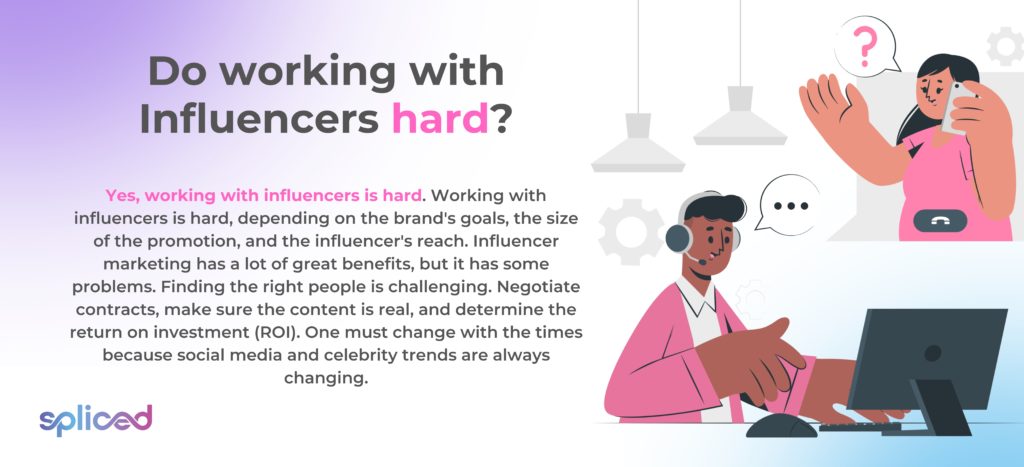
Do working with Influencers hard?
Yes, working with influencers is hard. Working with influencers is hard, depending on the brand’s goals, the size of the promotion, and the influencer’s reach. Influencer marketing has a lot of great benefits, but it has some problems. Finding the right people is challenging. Negotiate contracts, make sure the content is real, and determine the return on investment (ROI). One must change because social media and celebrity trends are always changing. Setting up and keeping up good contact with influential people is essential for collaboration to work. Influencer marketing is very effective for brands that take the time to learn about the influencer environment, set clear goals, and build good relationships with them.
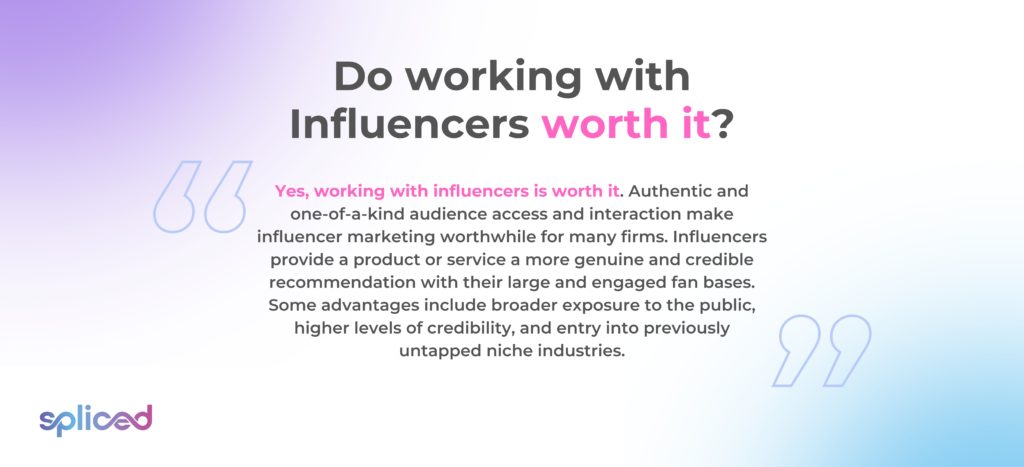
Do working with Influencers worth it?
Yes, working with influencers is worth it. Authentic and one-of-a-kind audience access and interaction make influencer marketing worthwhile for many firms. Influencers provide a product or service with a more genuine and credible recommendation with their large and engaged fan bases. Some advantages include broader exposure to the public, higher levels of credibility, and entry into previously untapped niche industries.
However, one must first plan ahead, thoroughly assess influencers, and communicate effectively to be a successful influencer. Successful influencer marketing does produce measurable outcomes, although it is difficult to calculate return on investment (ROI). The value of collaborating with influencers ultimately depends on the objectives of the company, the influencer’s compatibility with the brand’s mission, and the approach taken.

Do working with Influencers expensive?
Yes, working with influencers is expensive. However, Influencer marketing budgets vary greatly depending on variables including the influencer’s audience size, engagement rate, sector of business, and the scale of the campaign. Influencer fees exhibit variation based on the specific social media platform utilized and the content format being created, whether it’s a standard post, a short-lived story, or a full-fledged video. Nano and micro-influencers normally command substantially lower rates compared to their macro and mega counterparts. It’s pivotal to assess their financial plan, campaign objectives comprehensively, and projected return on investment (ROI) before embarking on an influencer collaboration for businesses venturing into influencer marketing. Engaging in meticulous dialogue and forging a collaborative relationship with influencers sustain a harmonious partnership without surpassing predetermined budget constraints.

What is the difference between an Influencer and a Content Creator?
The difference between an influencer and a content creator lies in the strategic intent. These two positions within the sphere of digital media and online presence are rather diverse from one another, although the phrases “influencer” and “content creator” are often used interchangeably. An influencer is a person who holds the power to change the thoughts, behaviors, and purchasing decisions of their audience, generally as a result of their genuineness, knowledge, or relatability in a certain field or field of endeavor. Influencers capitalize on their own personal brands to attract a dedicated following, and they frequently work in conjunction with brands on various promotional activities.
A content creator, on the other hand, is someone who makes and publishes a range of content across several platforms, such as videos, photographs, essays, or podcasts. Content creators are known as media producers. Independent of their ability to sway others, content creators concentrate on producing works that are interesting, educational, or entertaining for the people who consume their work. Content creation is an important part of influencers’ strategies, although some are driven by artistic expression, education, or entertainment. The fundamental difference resides in the strategic intent, which determines whether the emphasis is placed on building a group centered on influence or crafting diverse material for broader involvement.
